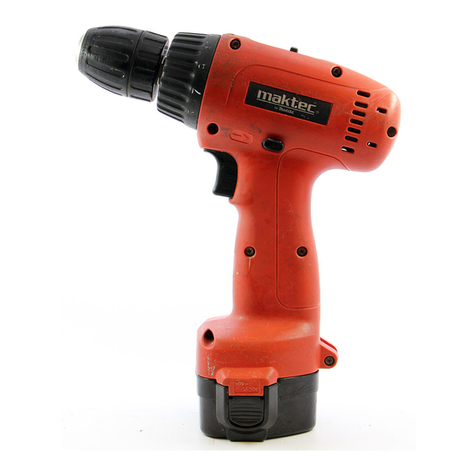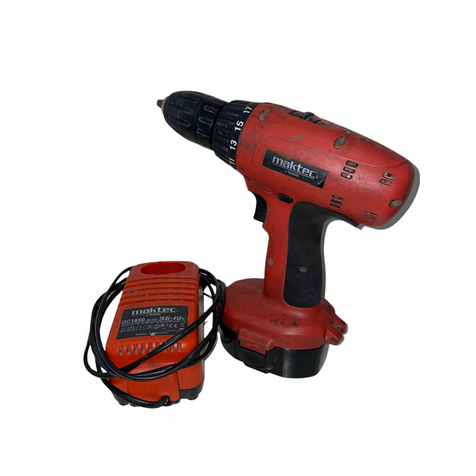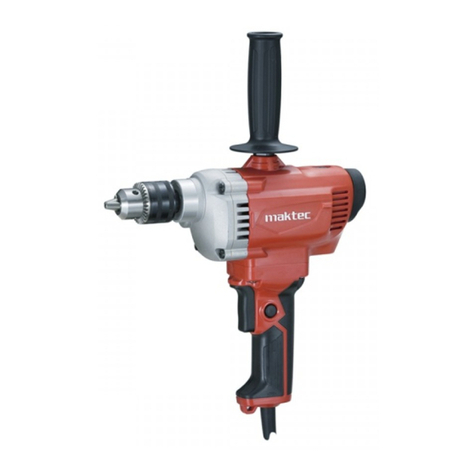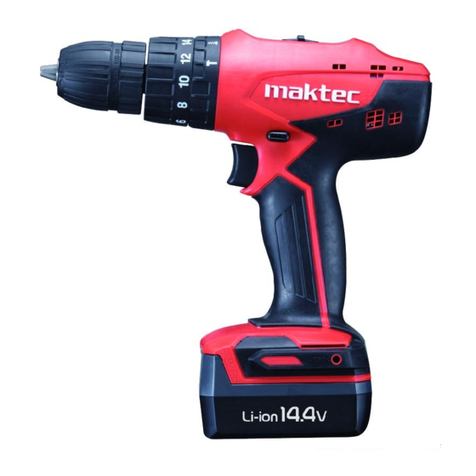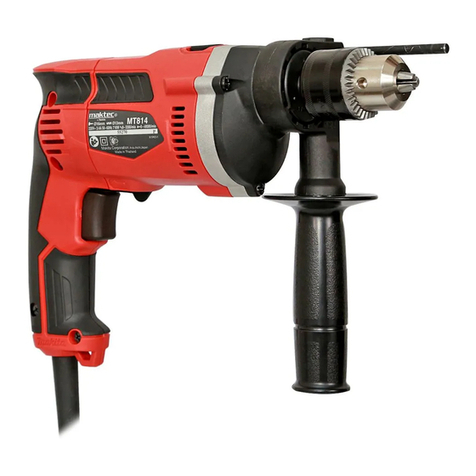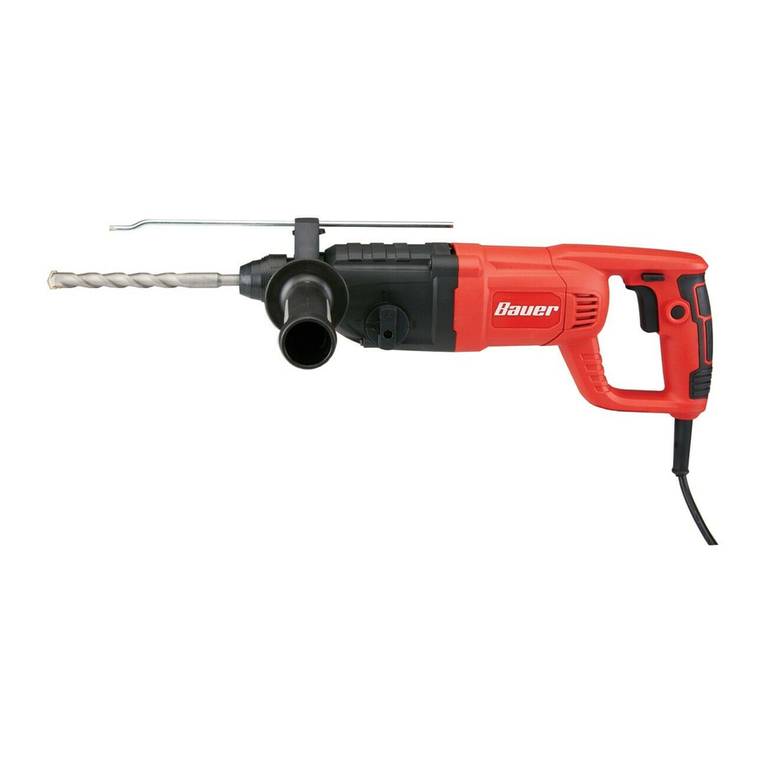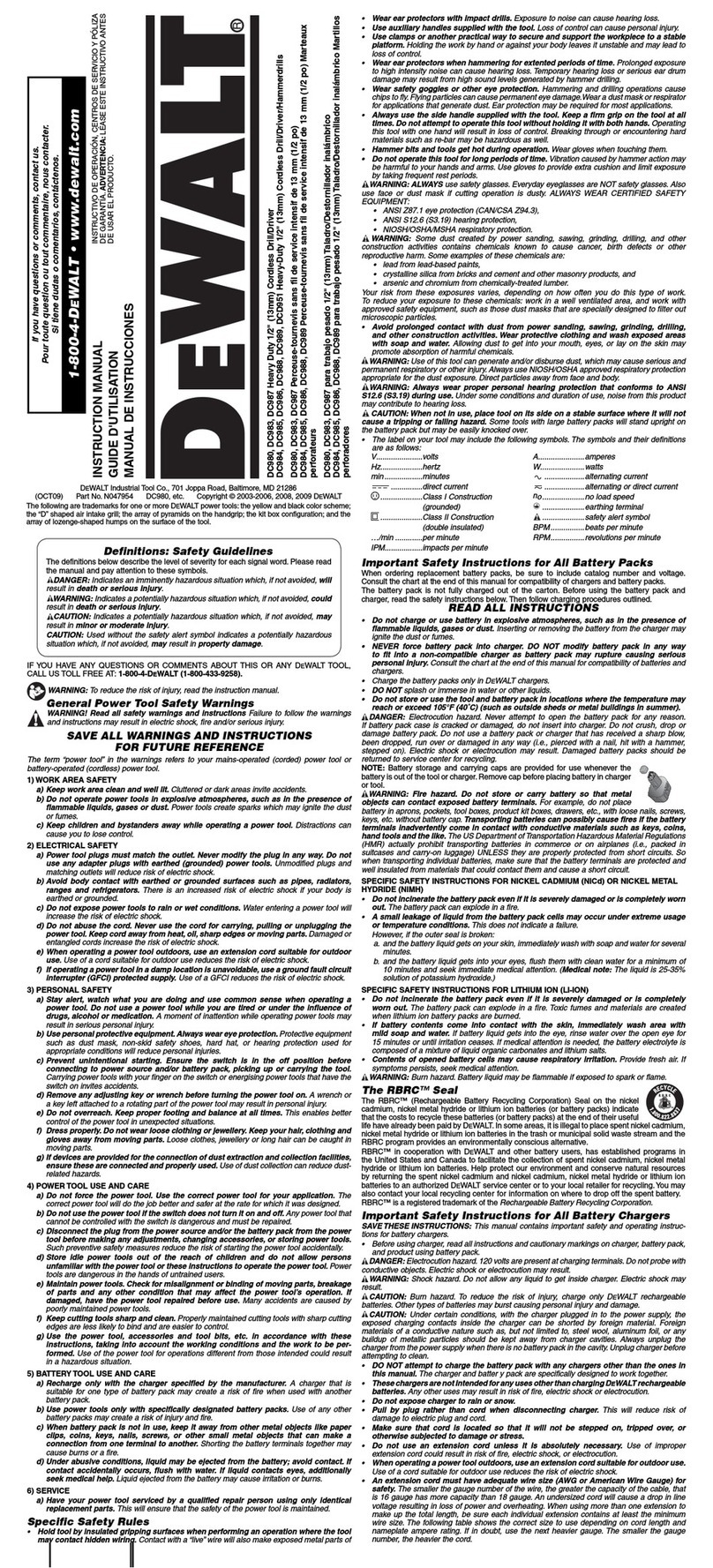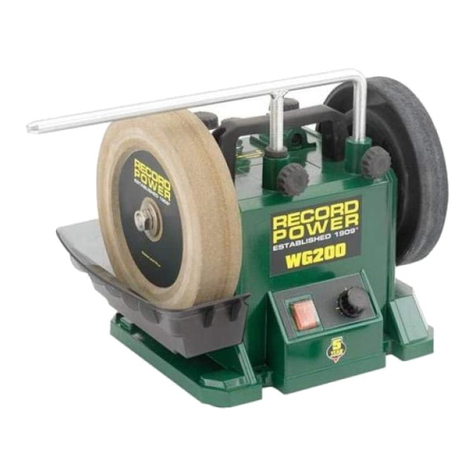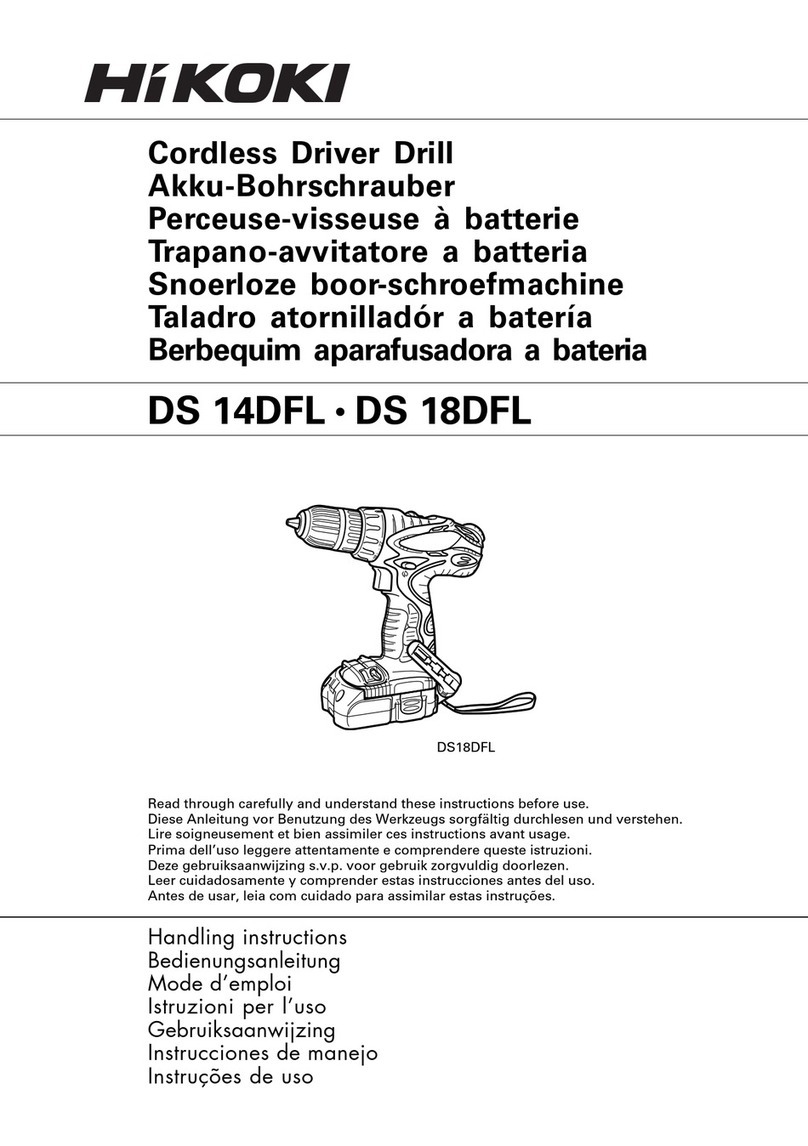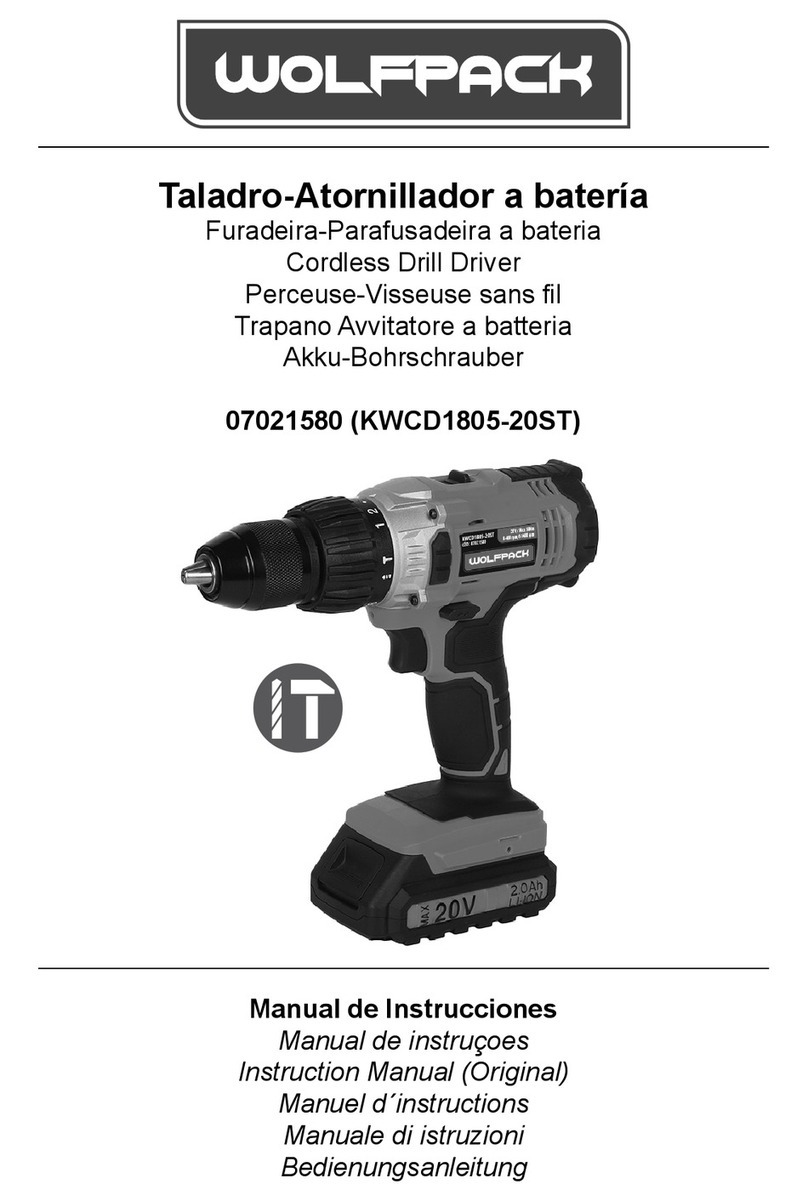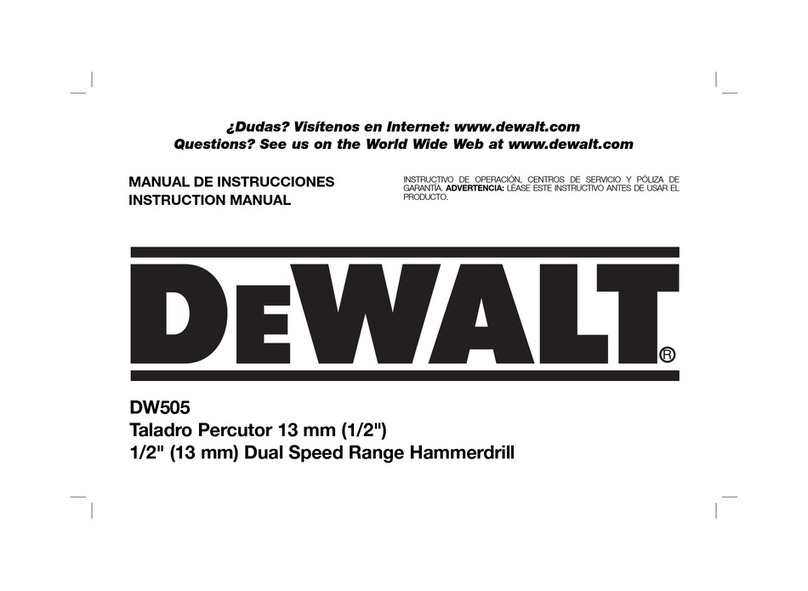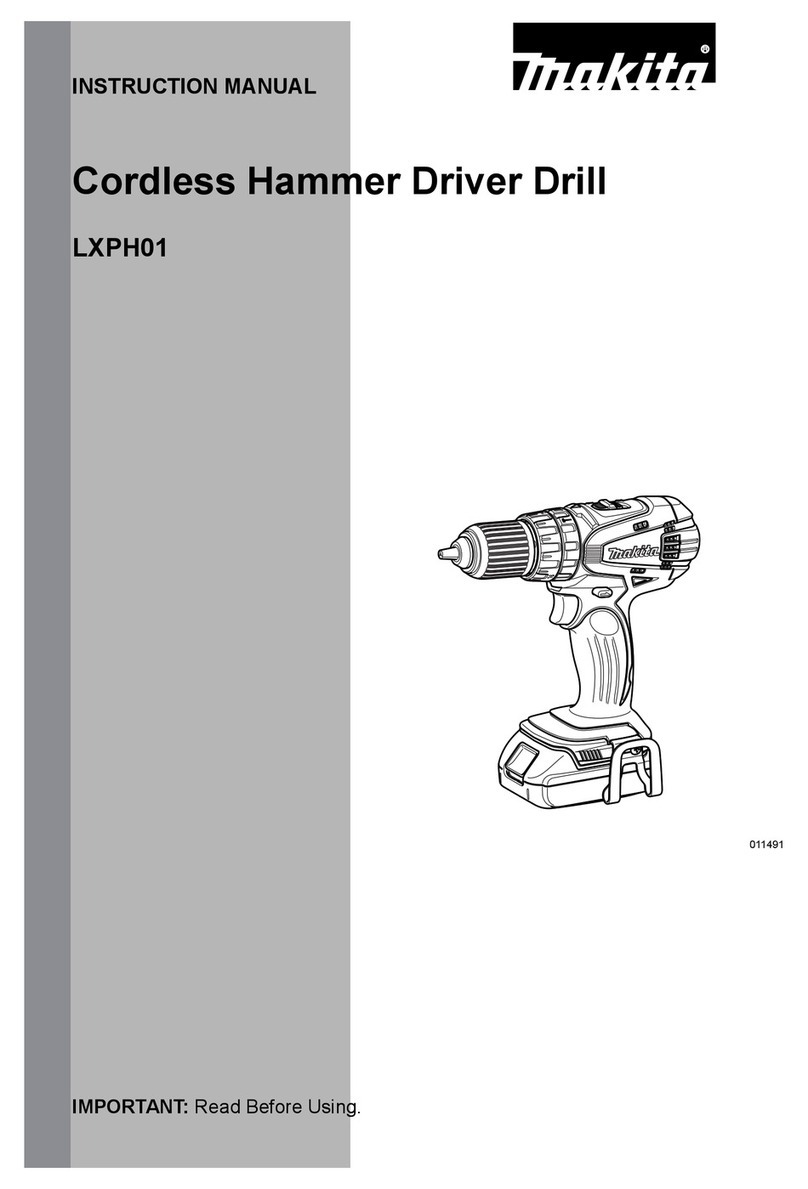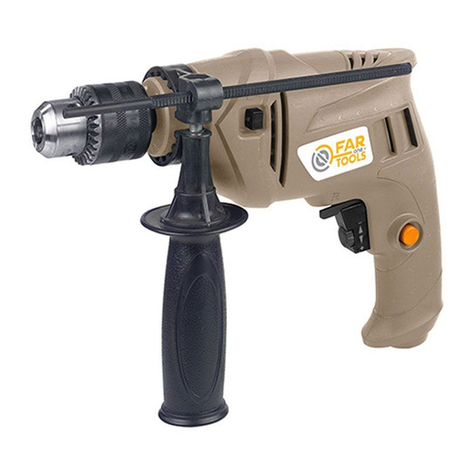Maktec MT080 User manual

Cordless Hammer Driver Drill Instruction manual
Bor Obeng Getar Tanpa Kabel Petunjuk penggunaan
Máy khoan búa chạy pin Tài liệu hướng dẫn
สวานไขควงตอกแบบไรสาย คูมือการใชงาน
GB
VI
TH
ID
MT080
MT081

2
1011803 2011804
3011805 4011807
5011806 6011808
7002449 8011809
1
23
4
A
5
B6
7
8
9
10
11
13
12
14

3
ENGLISH
Explanation of general view
SPECIFICATIONS
• Due to our continuing programme of research and development, the specifications herein are subject to change without
notice.
• Specifications and battery cartridge may differ from country to country.
• Weight, with battery cartridge, according to EPTA-Procedure 01/2003
END004-3
Symbols
The following show the symbols used for the equipment.
Be sure that you understand their meaning before use.
..... Read instruction manual.
ENE039-1
Intended use
The tool is intended for impact drilling in brick, concrete
and stone as well as for drilling without impact in wood,
metal, ceramic and plastic.
GEA006-2
General Power Tool Safety
Warnings
WARNING! Read all safety warnings and all
instructions. Failure to follow the warnings and
instructions may result in electric shock, fire and/or
serious injury.
Save all warnings and
instructions for future reference.
The term “power tool” in the warnings refers to your
mains-operated (corded) power tool or battery-operated
(cordless) power tool.
Work area safety
1. Keep work area clean and well lit. Cluttered or dark
areas invite accidents.
2. Do not operate power tools in explosive
atmospheres, such as in the presence of
flammable liquids, gases or dust. Power tools
create sparks which may ignite the dust or fumes.
3. Keep children and bystanders away while
operating a power tool. Distractions can cause you
to lose control.
Electrical safety
4. Power tool plugs must match the outlet. Never
modify the plug in any way. Do not use any
adapter plugs with earthed (grounded) power
tools. Unmodified plugs and matching outlets will
reduce risk of electric shock.
5. Avoid body contact with earthed or grounded
surfaces such as pipes, radiators, ranges and
refrigerators. There is an increased risk of electric
shock if your body is earthed or grounded.
6. Do not expose power tools to rain or wet
conditions. Water entering a power tool will increase
the risk of electric shock.
7. Do not abuse the cord. Never use the cord for
carrying, pulling or unplugging the power tool.
Keep cord away from heat, oil, sharp edges or
moving parts. Damaged or entangled cords increase
the risk of electric shock.
1. Red indicator
2. Button
3. Battery cartridge
4. Switch trigger
5. Reversing switch lever
6. Speed change lever
7. Adjusting ring
8. Graduation
9. Action mode changing ring
10. Arrow
11. Chuck
12. Sleeve
13. Tighten
14. Blow-out bulb
Model MT080 MT081
Capacities
Concrete 10 mm 13 mm
Steel 10 mm 13 mm
Wood 25 mm 36 mm
Wood screw 5.1 mm x 63 mm 6 mm x 75 mm
Machine screw 6 mm
No load speed (min-1)High (2) 0 - 1,400
Low (1) 0 - 400
Blows per minute (min-1)High (2) 0 - 21,000
Low (1) 0 - 6,000
Overall length 216 mm 238 mm
Net weight 1.5 kg 1.7 kg
Rated voltage D.C. 14.4 V D.C. 18 V

4
8. When operating a power tool outdoors, use an
extension cord suitable for outdoor use. Use of a
cord suitable for outdoor use reduces the risk of
electric shock.
9. If operating a power tool in a damp location is
unavoidable, use a ground fault circuit interrupter
(GFCI) protected supply. Use of an GFCI reduces
the risk of electric shock.
Personal safety
10. Stay alert, watch what you are doing and use
common sense when operating a power tool. Do
not use a power tool while you are tired or under
the influence of drugs, alcohol or medication. A
moment of inattention while operating power tools
may result in serious personal injury.
11. Use personal protective equipment. Always wear
eye protection. Protective equipment such as dust
mask, non-skid safety shoes, hard hat, or hearing
protection used for appropriate conditions will reduce
personal injuries.
12. Prevent unintentional starting. Ensure the switch
is in the off-position before connecting to power
source and/or battery pack, picking up or carrying
the tool. Carrying power tools with your finger on the
switch or energising power tools that have the switch
on invites accidents.
13. Remove any adjusting key or wrench before
turning the power tool on. A wrench or a key left
attached to a rotating part of the power tool may result
in personal injury.
14. Do not overreach. Keep proper footing and
balance at all times. This enables better control of
the power tool in unexpected situations.
15. Dress properly. Do not wear loose clothing or
jewellery. Keep your hair, clothing, and gloves
away from moving parts. Loose clothes, jewellery or
long hair can be caught in moving parts.
16. If devices are provided for the connection of dust
extraction and collection facilities, ensure these
are connected and properly used. Use of dust
collection can reduce dust-related hazards.
Power tool use and care
17. Do not force the power tool. Use the correct power
tool for your application. The correct power tool will
do the job better and safer at the rate for which it was
designed.
18. Do not use the power tool if the switch does not
turn it on and off. Any power tool that cannot be
controlled with the switch is dangerous and must be
repaired.
19. Disconnect the plug from the power source and/or
the battery pack from the power tool before
making any adjustments, changing accessories,
or storing power tools. Such preventive safety
measures reduce the risk of starting the power tool
accidentally.
20. Store idle power tools out of the reach of children
and do not allow persons unfamiliar with the
power tool or these instructions to operate the
power tool. Power tools are dangerous in the hands
of untrained users.
21. Maintain power tools. Check for misalignment or
binding of moving parts, breakage of parts and
any other condition that may affect the power
tool’s operation. If damaged, have the power tool
repaired before use. Many accidents are caused by
poorly maintained power tools.
22. Keep cutting tools sharp and clean. Properly
maintained cutting tools with sharp cutting edges are
less likely to bind and are easier to control.
23. Use the power tool, accessories and tool bits etc.
in accordance with these instructions, taking into
account the working conditions and the work to
be performed. Use of the power tool for operations
different from those intended could result in a
hazardous situation.
Battery tool use and care
24. Recharge only with the charger specified by the
manufacturer. A charger that is suitable for one type
of battery pack may create a risk of fire when used
with another battery pack.
25. Use power tools only with specifically designated
battery packs. Use of any other battery packs may
create a risk of injury and fire.
26. When battery pack is not in use, keep it away from
other metal objects, like paper clips, coins, keys,
nails, screws or other small metal objects, that can
make a connection from one terminal to another.
Shorting the battery terminals together may cause
burns or a fire.
27. Under abusive conditions, liquid may be ejected
from the battery; avoid contact. If contact
accidentally occurs, flush with water. If liquid
contacts eyes, additionally seek medical help.
Liquid ejected from the battery may cause irritation or
burns.
Service
28. Have your power tool serviced by a qualified
repair person using only identical replacement
parts. This will ensure that the safety of the power tool
is maintained.
29. Follow instruction for lubricating and changing
accessories.
30. Keep handles dry, clean and free from oil and
grease.
GEB056-3
CORDLESS HAMMER DRILL
SAFETY WARNINGS
1. Wear ear protectors when impact drilling.
Exposure to noise can cause hearing loss.
2. Use auxiliary handle(s), if supplied with the tool.
Loss of control can cause personal injury.
3. Hold power tool by insulated gripping surfaces,
when performing an operation where the cutting
accessory may contact hidden wiring. Cutting
accessory contacting a “live” wire may make exposed
metal parts of the power tool “live” and could give the
operator an electric shock.
4. Always be sure you have a firm footing.
Be sure no one is below when using the tool in
high locations.
5. Hold the tool firmly.
6. Keep hands away from rotating parts.

5
7. Do not leave the tool running. Operate the tool
only when hand-held.
8. Do not touch the bit or the workpiece immediately
after operation; they may be extremely hot and
could burn your skin.
9. Some material contains chemicals which may be
toxic. Take caution to prevent dust inhalation and
skin contact. Follow material supplier safety data.
SAVE THESE INSTRUCTIONS.
WARNING:
DO NOT let comfort or familiarity with product (gained
from repeated use) replace strict adherence to safety
rules for the subject product. MISUSE or failure to
follow the safety rules stated in this instruction
manual may cause serious personal injury.
ENC009-1
IMPORTANT SAFETY
INSTRUCTIONS
FOR BATTERY CARTRIDGE
1. Before using battery cartridge, read all
instructions and cautionary markings on (1)
battery charger, (2) battery, and (3) product using
battery.
2. Do not disassemble battery cartridge.
3. If operating time has become excessively shorter,
stop operating immediately. It may result in a risk
of overheating, possible burns and even an
explosion.
4. If electrolyte gets into your eyes, rinse them out
with clear water and seek medical attention right
away. It may result in loss of your eyesight.
5. Do not short the battery cartridge:
(1) Do not touch the terminals with any
conductive material.
(2) Avoid storing battery cartridge in a container
with other metal objects such as nails, coins,
etc.
(3) Do not expose battery cartridge to water or
rain.
A battery short can cause a large current flow,
overheating, possible burns and even a
breakdown.
6. Do not store the tool and battery cartridge in
locations where the temperature may reach or
exceed 50°C (122°F).
7. Do not incinerate the battery cartridge even if it is
severely damaged or is completely worn out. The
battery cartridge can explode in a fire.
8. Be careful not to drop or strike battery.
9. Do not use a damaged battery.
SAVE THESE INSTRUCTIONS.
Tips for maintaining maximum battery life
1. Charge the battery cartridge before completely
discharged.
Always stop tool operation and charge the battery
cartridge when you notice less tool power.
2. Never recharge a fully charged battery cartridge.
Overcharging shortens the battery service life.
3. Charge the battery cartridge with room
temperature at 10°C - 40°C (50°F - 104°F). Let a hot
battery cartridge cool down before charging it.
FUNCTIONAL DESCRIPTION
CAUTION:
• Always be sure that the tool is switched off and the
battery cartridge is removed before adjusting or
checking function on the tool.
Installing or removing battery cartridge
(Fig. 1)
• Always switch off the tool before installing or removing
of the battery cartridge.
• To remove the battery cartridge, slide it from the tool
while sliding the button on the front of the cartridge.
• To install the battery cartridge, align the tongue on the
battery cartridge with the groove in the housing and slip
it into place. Always insert it all the way until it locks in
place with a little click. If you can see the red indicator
on the upper side of the button, it is not locked
completely. Install it fully until the red indicator cannot
be seen. If not, it may accidentally fall out of the tool,
causing injury to you or someone around you.
• Do not use force when installing the battery cartridge. If
the cartridge does not slide in easily, it is not being
inserted correctly.
Battery protection system
The battery cartridge is equipped with the protection
system, which automatically cuts off the output power for
its long service life.
The tool stops during operation when the tool and/or
battery are placed under the following situation. This is
caused by the activation of protection system and does
not show the tool trouble.
• When the tool is overloaded:
At this time, release the switch trigger, remove the
battery cartridge and remove causes of overload
and then pull the switch trigger again to restart.
• When battery cells get hot:
If any operation of the switch trigger, the motor will
remain stopped. At this time, stop use of the tool
and cool the battery cartridge.
• When the remaining battery capacity gets low:
If you pull the switch trigger, the motor runs again
but stops soon. In this case, to prevent over
discharge, remove the battery cartridge from the
tool and charge it.
Switch action (Fig. 2)
CAUTION:
• Before inserting the battery cartridge into the tool,
always check to see that the switch trigger actuates
properly and returns to the “OFF” position when
released.
To start the tool, simply pull the switch trigger. Tool speed
is increased by increasing pressure on the switch trigger.
Release the switch trigger to stop.

6
Reversing switch action (Fig. 3)
This tool has a reversing switch to change the direction of
rotation. Depress the reversing switch lever from the A
side for clockwise rotation or from the B side for
counterclockwise rotation.
When the reversing switch lever is in the neutral position,
the switch trigger cannot be pulled.
CAUTION:
• Always check the direction of rotation before operation.
• Use the reversing switch only after the tool comes to a
complete stop. Changing the direction of rotation
before the tool stops may damage the tool.
• When not operating the tool, always set the reversing
switch lever to the neutral position.
Speed change (Fig. 4)
To change the speed, first switch off the tool and then
slide the speed change lever to the “2” side for high speed
or “1” side for low speed. Be sure that the speed change
lever is set to the correct position before operation. Use
the right speed for your job.
CAUTION:
• Always set the speed change lever fully to the correct
position. If you operate the tool with the speed change
lever positioned halfway between the “1” side and “2”
side, the tool may be damaged.
• Do not use the speed change lever while the tool is
running. The tool may be damaged.
Selecting the action mode (Fig. 5)
This tool employs an action mode changing ring. Select
one of the three modes suitable for your work needs by
using this ring.
For rotation only, turn the ring so that the arrow on the tool
body points toward the mark on the ring.
For rotation with hammering, turn the ring so that the
arrow points toward the mark on the ring.
For rotation with clutch, turn the ring so that the arrow
points toward the mark on the ring.
CAUTION:
• Always set the ring correctly to your desired mode
mark. If you operate the tool with the ring positioned
halfway between the mode marks, the tool may be
damaged.
Adjusting the fastening torque (Fig. 5)
The fastening torque can be adjusted in 16 steps by
turning the adjusting ring so that its graduations are
aligned with the arrow on the tool body. The fastening
torque is minimum when the number 1 is aligned with the
arrow, and maximum when the number 16 is aligned with
the arrow.
Before actual operation, drive a trial screw into your
material or a piece of duplicate material to determine
which torque level is required for a particular application.
ASSEMBLY
CAUTION:
• Always be sure that the tool is switched off and the
battery cartridge is removed before carrying out any
work on the tool.
Installing or removing driver bit or drill bit
(Fig. 6)
Turn the sleeve counterclockwise to open the chuck jaws.
Place the bit in the chuck as far as it will go. Turn the
sleeve clockwise to tighten the chuck.
To remove the bit, turn the sleeve counterclockwise.
OPERATION
Hammer drilling operation
CAUTION:
• There is a tremendous and sudden twisting force
exerted on the tool/bit at the time of hole break-
through, when the hole becomes clogged with chips
and particles, or when striking reinforcing rods
embedded in the concrete.
First, turn the action mode changing ring so that the arrow
on the tool body points to the marking. The adjusting
ring can be aligned in any torque levels for this operation.
Be sure to use a tungsten-carbide tipped bit.
Position the bit at the desired location for the hole, then
pull the switch trigger. Do not force the tool. Light pressure
gives best results. Keep the tool in position and prevent it
from slipping away from the hole.
Do not apply more pressure when the hole becomes
clogged with chips or particles. Instead, run the tool at an
idle, then remove the bit partially from the hole. By
repeating this several times, the hole will be cleaned out
and normal drilling may be resumed.
Blow-out bulb (optional accessory)
(Fig. 7)
After drilling the hole, use the blow-out bulb to clean the
dust out of the hole.
Screwdriving operation (Fig. 8)
First, turn the action mode changing ring so that the arrow
on the tool body points to the marking. Adjust the
adjusting ring to the proper torque level for your work.
Then proceed as follows.
Place the point of the driver bit in the screw head and
apply pressure to the tool. Start the tool slowly and then
increase the speed gradually. Release the switch trigger
as soon as the clutch cuts in.
CAUTION:
• Make sure that the driver bit is inserted straight in the
screw head, or the screw and/or bit may be damaged.
NOTE:
• When driving wood screws, predrill pilot holes to make
driving easier and to prevent splitting of the workpiece.
See the chart.

7
006421
Drilling operation
First, turn the adjusting ring so that the pointer points to
the marking. Then proceed as follows.
CAUTION:
• Pressing excessively on the tool will not speed up the
drilling. In fact, this excessive pressure will only serve
to damage the tip of your bit, decrease the tool
performance and shorten the service life of the tool.
• There is a tremendous force exerted on the tool/bit at
the time of hole break through. Hold the tool firmly and
exert care when the bit begins to break through the
workpiece.
• A stuck bit can be removed simply by setting the
reversing switch to reverse rotation in order to back
out. However, the tool may back out abruptly if you do
not hold it firmly.
• Always secure small workpieces in a vise or similar
hold-down device.
• If the tool is operated continuously until the battery
cartridge has discharged, allow the tool to rest for 15
minutes before proceeding with a fresh battery.
Drilling in wood
When drilling in wood, the best results are obtained with
wood drills equipped with a guide screw. The guide screw
makes drilling easier by pulling the bit into the workpiece.
Drilling in metal
To prevent the bit from slipping when starting a hole, make
an indentation with a center-punch and hammer at the
point to be drilled. Place the point of the bit in the
indentation and start drilling.
Use a cutting lubricant when drilling metals. The
exceptions are iron and brass which should be drilled dry.
MAINTENANCE
CAUTION:
• Always be sure that the tool is switched off and the
battery cartridge is removed before attempting to
perform inspection or maintenance.
• Never use gasoline, benzine, thinner, alcohol or the
like. Discoloration, deformation or cracks may result.
To maintain product SAFETY and RELIABILITY, repairs,
any other maintenance or adjustment should be
performed by Makita Authorized Service Centers, always
using Makita replacement parts.
Nominal diameter of
wood screw (mm)
Recommended size of
pilot hole (mm)
3.1 2.0 - 2.2
3.5 2.2 - 2.5
3.8 2.5 - 2.8
4.5 2.9 - 3.2
4.8 3.1 - 3.4
5.1 3.3 - 3.6
5.5 3.7 - 3.9
5.8 4.0 - 4.2
6.1 4.2 - 4.4

8
BAHASA INDONESIA
Penjelasan tampilan keseluruhan
SPESIFIKASI
• Karena kesinambungan program penelitian dan pengembangan kami, spesifikasi yang disebutkan di sini dapat
berubah tanpa pemberitahuan.
• Spesifikasi dan baterai dapat berbeda dari satu negara ke negara lainnya.
• Berat, dengan baterai, menurut Prosedur EPTA 01/2003
END004-3
Simbol
Berikut ini adalah simbol-simbol yang digunakan pada
peralatan ini. Pastikan Anda mengerti makna masing-
masing simbol sebelum menggunakan alat.
..... Baca petunjuk penggunaan.
ENE039-1
Penggunaan
Mesin ini digunakan untuk membor kejut batu bata, beton
dan batu serta juga untuk membor tanpa kejut kayu,
logam, keramik dan plastik.
GEA006-2
Peringatan Keselamatan Umum
Mesin Listrik
PERINGATAN! Bacalah semua peringatan
keselamatan dan semua petunjuk. Kelalaian mematuhi
peringatan dan petunjuk dapat menyebabkan sengatan
listrik, kebakaran dan/atau cedera serius.
Simpanlah semua peringatan dan
petunjuk untuk acuan di masa
depan.
Istilah “mesin listrik” dalam semua peringatan mengacu
pada mesin listrik yang dijalankan dengan sumber listrik
jala-jala (berkabel) atau baterai (tanpa kabel).
Keselamatan tempat kerja
1. Jaga tempat kerja selalu bersih dan
berpenerangan cukup. Tempat kerja yang
berantakan dan gelap mengundang kecelakaan.
2. Jangan gunakan mesin listrik dalam lingkungan
yang mudah meledak, misalnya jika ada cairan,
gas, atau debu yang mudah menyala. Mesin listrik
menimbulkan bunga api yang dapat menyalakan debu
atau uap tersebut.
3. Jauhkan anak-anak dan orang lain saat
menggunakan mesin listrik. Bila perhatian terpecah,
anda dapat kehilangan kendali.
Keamanan kelistrikan
4. Steker mesin listrik harus cocok dengan
stopkontak. Jangan sekali-kali mengubah steker
dengan cara apa pun. Jangan menggunakan
steker adaptor dengan mesin listrik berarde
(dibumikan). Steker yang tidak diubah dan
stopkontak yang cocok akan mengurangi risiko
sengatan listrik.
1. Indikator berwarna merah
2. Tombol
3. Baterai
4. Picu saklar
5. Tuas saklar pembalik arah
6. Tuas pengubah kecepatan
7. Cincin penyetel
8. Skala
9. Cincin pengganti sistem kerja
10. Tanda panah
11. Kunci
12. Selongsong
13. Kencangkan
14. Penghembus angi
Model MT080 MT081
Kapasitas
Beton 10 mm 13 mm
Baja 10 mm 13 mm
Kayu 25 mm 36 mm
Sekrup kayu 5,1 mm x 63 mm 6 mm x 75 mm
Sekrup mesin 6 mm
Kecepatan tanpa beban (min-1)Tinggi (2) 0 - 1.400
Rendah (1) 0 - 400
Hembusan per menit (min-1)Tinggi (2) 0 - 21.000
Rendah (1) 0 - 6.000
Panjang keseluruhan 216 mm 238 mm
Berat bersih 1,5 kg 1,7 kg
Tegangan terukur D.C. 14,4 V D.C. 18 V

9
5. Hindari sentuhan tubuh dengan permukaan
berarde atau yang dibumikan seperti pipa,
radiator, kompor, dan kulkas. Risiko sengatan listrik
bertambah jika tubuh Anda terbumikan atau terarde.
6. Jangan membiarkan mesin listrik kehujanan atau
kebasahan. Air yang masuk ke dalam mesin listrik
akan meningkatkan risiko sengatan listrik.
7. Jangan menyalahgunakan kabel. Jangan sekali-
kali menggunakan kabel untuk membawa,
menarik, atau mencabut mesin listrik dari
stopkontak. Jauhkan kabel dari panas, minyak,
tepian tajam, atau bagian yang bergerak. Kabel
yang rusak atau kusut memperbesar risiko sengatan
listrik.
8. Bila menggunakan mesin listrik di luar ruangan,
gunakan kabel ekstensi yang sesuai untuk
penggunaan di luar ruangan. Penggunaan kabel
yang sesuai untuk penggunaan luar ruangan
mengurangi risiko sengatan listrik.
9. Jika mengoperasikan mesin listrik di lokasi
lembap tidak terhindarkan, gunakan pasokan daya
yang dilindungi pemutus rangkaian salah arde
(ground fault circuit interrupter - GFCI).
Penggunaan GFCI mengurangi risiko sengatan listrik.
Keselamatan diri
10. Jaga kewaspadaan, perhatikan pekerjaan Anda
dan gunakan akal sehat bila menggunakan mesin
listrik. Jangan menggunakan mesin listrik saat
Anda lelah atau di bawah pengaruh obat bius,
alkohol, atau obat. Sekejap saja lalai saat
menggunakan mesin listrik dapat menyebabkan
cedera diri yang serius.
11. Gunakan alat pelindung diri. Selalu gunakan
pelindung mata. Peralatan pelindung seperti masker
debu, sepatu pengaman anti-selip, helm pengaman,
atau pelindung telinga yang digunakan untuk kondisi
yang sesuai akan mengurangi risiko cedera diri.
12. Cegah penyalaan yang tidak disengaja. Pastikan
bahwa sakelar berada dalam posisi mati (off)
sebelum menghubungkan mesin ke sumber daya
dan/atau baterai, mengangkat atau membawanya.
Membawa mesin listrik dengan jari Anda pada
sakelarnya atau mengalirkan listrik pada mesin listrik
yang sakelarnya hidup (on) akan mengundang
kecelakaan.
13. Lepaskan kunci-kunci penyetel sebelum
menghidupkan mesin listrik. Kunci-kunci yang
masih terpasang pada bagian mesin listrik yang
berputar dapat menyebabkan cedera.
14. angan meraih terlalu jauh. Jagalah pijakan dan
keseimbangan sepanjang waktu. Hal ini
memungkinkan kendali yang lebih baik atas mesin
listrik dalam situasi yang tidak diharapkan.
15. Kenakan pakaian dengan baik. Jangan memakai
pakaian yang kedodoran atau perhiasan. Jaga
jarak antara rambut, pakaian, dan sarung tangan
Anda dengan bagian mesin yang bergerak.
Pakaian kedodoran, perhiasan, atau rambut panjang
dapat tersangkut pada bagian yang bergerak.
16. Jika tersedia fasilitas untuk menghisap dan
mengumpulkan debu, pastikan fasilitas tersebut
terhubung listrik dan digunakan dengan baik.
Penggunaan pembersih debu dapat mengurangi
bahaya yang terkait dengan debu.
Penggunaan dan pemeliharaan mesin listrik
17. Jangan memaksa mesin listrik. Gunakan mesin
listrik yang tepat untuk keperluan Anda. Mesin
listrik yang tepat akan menuntaskan pekerjaan
dengan lebih baik dan aman pada kecepatan sesuai
rancangannya.
18. Jangan gunakan mesin listrik jika sakelar tidak
dapat menyalakan dan mematikannya. Mesin listrik
yang tidak dapat dikendalikan dengan sakelarnya
adalah berbahaya dan harus diperbaiki.
19. Cabut steker dari sumber listrik dan/atau baterai
dari mesin listrik sebelum melakukan penyetelan,
penggantian aksesori, atau menyimpan mesin
listrik. Langkah keselamatan preventif tersebut
mengurangi risiko hidupnya mesin secara tak
sengaja.
20. Simpan mesin listrik jauh dari jangkauan anak-
anak dan jangan biarkan orang yang tidak paham
mengenai mesin listrik tersebut atau petunjuk ini
menggunakan mesin listrik. Mesin listrik sangat
berbahaya di tangan pengguna yang tak terlatih.
21. Rawatlah mesin listrik. Periksa apakah ada bagian
bergerak yang tidak lurus atau macet, bagian yang
pecah dan kondisi lain yang dapat mempengaruhi
penggunaan mesin listrik. Jika rusak, perbaiki
dahulu mesin listrik sebelum digunakan. Banyak
kecelakaan disebabkan oleh kurangnya pemeliharaan
mesin listrik.
22. Jaga agar mesin pemotong tetap tajam dan bersih.
Mesin pemotong yang terawat baik dengan mata
pemotong yang tajam tidak mudah macet dan lebih
mudah dikendalikan.
23. Gunakan mesin listrik, aksesori, dan mata mesin,
dll. sesuai dengan petunjuk ini, dengan
memperhitungkan kondisi kerja dan jenis
pekerjaan yang dilakukan. Penggunaan mesin listrik
untuk penggunaan yang lain dari peruntukan dapat
menimbulkan situasi berbahaya.
Penggunaan dan pemeliharaan mesin bertenaga
baterai
24. Isi ulang baterai hanya dengan pengisi daya yang
ditentukan oleh pabrikan. Pengisi daya yang cocok
untuk satu jenis baterai dapat menimbulkan risiko
kebakaran ketika digunakan untuk paket baterai yang
lain.
25. Gunakan mesin listrik hanya dengan baterai yang
telah ditentukan secara khusus. Penggunaan
baterai lain dapat menimbulkan risiko cedera dan
kebakaran.
26. Ketika baterai tidak digunakan, jauhkan dari
benda logam lain, seperti penjepit kertas, uang
logam, kunci, paku, sekrup atau benda logam kecil
lainnya, yang dapat menghubungkan satu
terminal ke terminal lain. Hubungan singkat terminal
baterai dapat menyebabkan luka bakar atau
kebakaran.
27. Pemakaian yang salah, dapat menyebabkan
keluarnya cairan dari baterai; hindari kontak. Jika
terjadi kontak secara tidak sengaja, bilas dengan
air. Jika cairan mengenai mata, cari bantuan
medis. Cairan yang keluar dari baterai bisa
menyebabkan iritasi atau luka bakar.

10
Servis
28. Berikan mesin listrik untuk diperbaiki hanya
kepada oleh teknisi yang berkualifikasi dengan
menggunakan hanya suku cadang pengganti yang
serupa. Hal ini akan menjamin terjaganya keamanan
mesin listrik.
29. Patuhi petunjuk pelumasan dan penggantian
aksesori.
30. Jagalah agar gagang kering, bersih, dan bebas
dari minyak dan gemuk.
GEB056-3
PERINGATAN KESELAMATAN
BOR GETAR
1. Kenakan pelindung telinga saat melakukan
pengeboran tumbuk (impact drilling). Terpaan
kebisingan dapat menyebabkan hilangnya
pendengaran.
2. Gunakan gagang tambahan, jika disertakan
bersama mesin ini. Kehilangan kendali dapat
menyebabkan cedera.
3. Pegang mesin listrik pada permukaan genggam
yang terisolasi saat melakukan pekerjaan bila
aksesori pemotong mungkin bersentuhan dengan
kawat tersembunyi. Aksesori pemotong yang
menyentuh kawat “hidup” dapat menyebabkan bagian
logam pada mesin teraliri arus listrik dan menyengat
pengguna.
4. Selalu pastikan Anda berada di atas alas yang
kuat.
Pastikan tidak ada orang di bawahnya bila Anda
menggunakan mesin di tempat yang tinggi.
5. Pegang mesin kuat-kuat.
6. Jauhkan tangan dari bagian yang berputar.
7. Jangan tinggalkan mesin dalam keadaan hidup.
Jalankan mesin hanya ketika digenggam tangan.
8. Jangan menyentuh mata mesin atau benda kerja
segera setelah pengoperasian; suhunya mungkin
masih sangat panas dan dapat membakar kulit
Anda.
9. Bahan tertentu mengandung zat kimia yang
mungkin beracun. Hindari menghirup debu dan
persentuhan dengan kulit. Ikuti data keselamatan
bahan dari pemasok.
SIMPAN PETUNJUK INI.
PERINGATAN:
JANGAN biarkan kenyamanan atau terbiasanya Anda
dengan produk (karena penggunaan berulang)
menggantikan kepatuhan yang ketat terhadap aturan
keselamatan untuk produk yang terkait.
PENYALAHGUNAAN atau kelalaian mematuhi kaidah
keselamatan yang tertera dalam petunjuk ini dapat
menyebabkan cedera badan serius.
ENC009-1
PETUNJUK KESELAMATAN
PENTING
UNTUK BATERAI
1. Sebelum menggunakan baterai, bacalah semua
petunjuk dan penandaan pada (1) pengisi daya
baterai, (2) baterai, dan (3) produk yang
menggunakan baterai.
2. Jangan membongkar baterai.
3. Jika waktu beroperasinya menjadi sangat singkat,
segera hentikan penggunaan. Hal tersebut dapat
menimbulkan risiko panas berlebih, kemungkinan
mengalami luka bakar atau bahkan terjadi ledakan.
4. Jika elektrolit mengenai mata Anda, basuh dengan
air bersih dan segera cari pertolongan medis. Hal
tersebut dapat mengakibatkan hilangnya
kemampuan penglihatan Anda.
5. Jangan menghubungkan terminal baterai:
(1) Jangan menyentuhkan terminal dengan bahan
penghantar listrik apapun.
(2) Hindari menyimpan baterai pada wadah yang
berisi benda logam lain seperti paku, uang
logam, dsb.
(3) Jangan membiarkan baterai terkena air atau
kehujanan.
Hubungan singkat baterai dapat menyebabkan
aliran arus listrik yang besar, panas berlebih,
kemungkinan mengalami luka bakar dan bahkan
kerusakan pada baterai.
6. Jangan menyimpan mesin dan baterai pada lokasi
dengan suhu yang bisa mencapai atau melebihi
50°C.
7. Jangan membuang baterai di tempat pembakaran
sampah walaupun benar-benar rusak atau tidak
bisa digunakan sama sekali. Baterai bisa meledak
jika terbakar.
8. Hati-hati jangan sampai baterai jatuh atau
terbentur.
9. Jangan menggunakan baterai yang rusak.
SIMPAN PETUNJUK INI.
Tip untuk menjaga agar umur pemakaian
baterai maksimum
1. Ganti baterai sebelum habis sama sekali.
Selalu hentikan penggunaan mesin dan ganti
baterai jika Anda melihat bahwa mesin kurang
tenaga.
2. Jangan pernah mengisi ulang baterai yang sudah
diisi penuh.
Pengisian ulang yang berlebih memperpendek
umur pemakaian baterai.
3. Isi ulang baterai pada suhu ruangan 10°C - 40°C.
Biarkan baterai yang panas menjadi dingin
terlebih dahulu sebelum diisi ulang.

11
DESKRIPSI FUNGSI
PERHATIAN:
• Selalu pastikan bahwa mesin dimatikan dan baterai
dilepas sebelum menyetel atau memeriksa kerja
mesin.
Memasang atau melepas baterai (Gb. 1)
• Selalu matikan mesin sebelum memasang atau
melepas baterai.
• Untuk melepas baterai, geser dari mesin sambil
menggeser tombol pada bagian depan baterai.
• Untuk memasang baterai, sejajarkan lidah baterai
dengan alur pada rumah dan masukkan ke dalam
tempatnya. Selalu masukkan seluruhnya sampai
terkunci pada tempatnya dan terdengar bunyi klik kecil.
Jika Anda bisa melihat indikator berwarna merah pada
sisi atas tombol, berarti tidak terkunci sepenuhnya.
Pasang sepenuhnya sampai indikator berwarna merah
tidak terlihat. Jika tidak, bisa terlepas dari mesin secara
tidak sengaja, menyebabkan luka pada Anda atau
orang di sekitar Anda.
• Jangan dipaksakan ketika memasang baterai. Jika
baterai tidak bergeser dengan mudah, berarti tidak
dimasukkan dengan benar.
Sistem perlindungan baterai
Baterai dilengkapi dengan sistem perlindungan, yang
secara otomatis memutuskan daya output agar umur
pemakaiannya lama.
Mesin berhenti saat penggunaan ketika mesin dan/atau
baterai berada dalam situasi berikut ini. Hal ini
disebabkan oleh pengaktifan sistem perlindungan dan
bukan merupakan masalah pada mesin.
• Ketika mesin mengalami kelebihan beban:
Pada kondisi ini, lepas picu saklar, lepas baterai
dan hilangkan penyebab kelebihan beban
kemudian tarik picu saklar lagi untuk
mengoperasikan kembali.
• Ketika sel baterai menjadi panas:
Jika ada pengoperasian picu saklar, motor akan
tetap berhenti. Pada kondisi ini, hentikan
penggunaan mesin dan biarkan baterai menjadi
dingin.
• Ketika kapasitas baterai yang tersisa menjadi rendah:
Jika Anda menarik picu saklar, motor menyala lagi
tetapi segera berhenti. Dalam kasus ini, untuk
mencegah kekosongan daya yang berlebihan,
lepas baterai dari mesin dan lakukan pengisian
daya.
Kerja saklar (Gb. 2)
PERHATIAN:
• Sebelum memasukkan baterai pada mesin, pastikan
picu saklar berfungsi dengan baik dan kembali ke
posisi "OFF" saat dilepas.
Untuk menjalankan mesin, cukup tarik picu saklarnya.
Kecepatan mesin akan meningkat dengan menambah
tekanan pada picu saklar. Lepaskan picu saklar untuk
berhenti.
Kerja saklar pembalik arah (Gb. 3)
Mesin ini memiliki saklar pembalik arah untuk mengubah
arah putaran. Tekan tuas saklar pembalik arah dari sisi A
untuk putaran searah jarum jam atau dari sisi B untuk
putaran berlawanan arah jarum jam.
Ketika tuas saklar pembalik arah pada posisi netral, picu
saklar tidak bisa ditarik.
PERHATIAN:
• Selalu periksa arah putaran sebelum penggunaan.
• Gunakan saklar pembalik arah hanya setelah mesin
berhenti penuh. Mengubah arah putaran sebelum
mesin berhenti dapat merusak mesin.
• Saat mesin tidak digunakan, selalu posisikan tuas
saklar pembalik arah pada posisi netral.
Perubahan kecepatan (Gb. 4)
Untuk mengubah kecepatan, pertama-tama matikan
mesin dan kemudian geser tuas pengubah kecepatan ke
sisi "2" untuk kecepatan tinggi atau "1" untuk kecepatan
rendah. Pastikan bahwa tuas pengubah kecepatan
diposisikan pada posisi yang tepat sebelum penggunaan.
Gunakan kecepatan yang tepat untuk pekerjaan Anda.
PERHATIAN:
• Selalu posisikan tuas pengubah kecepatan
sepenuhnya pada posisi yang tepat. Jika anda
menggunakan mesin dengan tuas pengubah
kecepatan berada di posisi tengah antara sisi "1" dan
sisi "2", mesin bisa rusak.
• Jangan menggunakan tuas pengubah kecepatan
ketika mesin sedang bekerja. Mesin bisa rusak.
Memilih mode kerja (Gb. 5)
Mesin ini menggunakan cincin pengubah mode kerja.
Pilih salah satu dari tiga mode yang sesuai dengan
kebutuhan pekerjaan Anda dengan menggunakan cincin
ini.
Untuk putaran saja, putar cincin sehingga tanda panah
pada badan mesin mengarah ke tanda pada cincin.
Untuk putaran dengan getar, putar cincin sehingga tanda
panah mengarah ke tanda pada cincin.
Untuk putaran dengan kopeling, putar cincin sehingga
tanda panah mengarah ke tanda pada cincin.
PERHATIAN:
• Selalu posisikan cincin dengan benar pada tanda
mode yang diinginkan. Jika anda memakai alat dengan
cincin berada di posisi tengah antara kedua tanda
mode alat bisa rusak.
Menyetel torsi pengencangan (Gb. 5)
Torsi pengencangan bisa disetel dalam 16 tahap dengan
memutar cincin penyetel sehingga skala tersebut
disejajarkan dengan tanda panah pada badan mesin.
Torsi pengencangan minimum ketika angka 1 disejajarkan
dengan tanda panah, dan maksimum ketika angka 16
disejajarkan dengan tanda panah.
Sebelum penggunaan yang sebenarnya, pasang sekrup
percobaan pada bahan atau potongan bahan lain untuk
menentukan tingkat torsi yang dibutuhkan untuk
keperluan tertentu.

12
PERAKITAN
PERHATIAN:
• Selalu pastikan bahwa mesin dimatikan dan baterai
dilepas sebelum melakukan pekerjaan apapun pada
mesin.
Memasang atau melepas mata obeng atau
mata bor (Gb. 6)
Putar selongsong berlawanan arah jarum jam untuk
membuka rahang cekam. Masukkan mata bor ke dalam
cekam sejauh mungkin. Putar selongsong searah jarum
jam untuk mengencangkan cekam.
Untuk melepas mata bor, putar selongsong berlawanan
arah jarum jam.
PENGGUNAAN
Cara pengoperasian bor getar
PERHATIAN:
• Akan timbul gaya yang sangat kuat dan tiba-tiba pada
mesin/mata mesin saat menembus lubang, bila lubang
dipenuhi geram-geram atau partikel, atau bila
menabrak besi-besi tulangan yang terpasang di dalam
beton.
Pertama-tama, putar cincin pengubah mode kerja
sehingga tanda panah pada badan mesin mengarah pada
tanda . Cincin penyetel bisa disejajarkan pada tingkat
torsi manapun untuk pengoperasian ini.
Pastikan Anda menggunakan mata bor berujung
tungsten-carbide.
Posisikan mata bor pada lokasi yang diinginkan untuk
lubang, kemudian tarik picu saklar. Jangan memaksa
mesin listrik. Tekanan yang ringan akan memberi hasil
yang terbaik. Jaga posisi mesin dan cegah agar tidak
selip dari lubang.
Jangan menambah tekanan bila lubang dipenuhi geram-
geram atau partikel. Tetapi, nyalakan alat tanpa putaran,
lalu angkat mata bor sedikit dari lubang. Dengan
melakukan hal ini beberapa kali, lubang akan besih dan
pengeboran normal bisa dilanjutkan kembali.
Penghembus angin (pilihan aksesori)
(Gb. 7)
Setelah mengebor lubang, gunakan penghembus angin
untuk membersihkan lubang dari debu.
Pekerjaan pemasangan sekrup (Gb. 8)
Pertama-tama, putar cincin pengubah mode kerja
sehingga tanda panah pada badan mesin mengarah pada
tanda . Setel cincin penyetel pada tingkat torsi yang
tepat untuk pekerjaan Anda. Kemudian lakukan
sebagaimana berikut.
Posisikan ujung mata obeng pada kepala sekrup dan beri
tekanan pada mesin. Jalankan mesin dengan perlahan
dan kemudian tingkatkan kecepatan secara bertahap.
Lepas picu saklar segera setelah kopeling memotong.
PERHATIAN:
• Pastikan bahwa mata obeng dimasukkan lurus
terhadap kepala sekrup, atau sekrup dan/atau mata
mesin bisa rusak.
CATATAN:
• Ketika memasang sekrup kayu, lakukan pengeboran
awal untuk membuat lubang pengarah agar
mempermudah pemasangan sekrup dan untuk
mencegah pecahnya benda kerja. Lihat tabel.
006421
Pekerjaan pengeboran
Pertama-tama, putar cincin penyetel sehingga penunjuk
mengarah pada tanda . Kemudian lakukan
sebagaimana berikut.
PERHATIAN:
• Menekan mesin secara berlebihan tidak akan
mempercepat pengeboran. Bahkan, tekanan yang
berlebihan hanya akan merusak mata bor Anda,
mengurangi kinerja mesin dan memperpendek usia
mesin.
• Akan timbul gaya yang sangat kuat pada mesin/mata
bor saat menembus lubang. Pegang mesin dengan
kuat dan berhati-hatilah saat mata bor menembus
benda kerja.
• Mata bor yang macet dapat dicabut dengan menyetel
saklar pembalik arah agar mesin berputar berlawanan
arah untuk mundur. Tetapi, mesin bisa saja mundur
mendadak jika Anda tidak memegangnya dengan kuat.
• Tahan benda kerja berukuran kecil dengan penjepit
atau alat penahan lain.
• Jika mesin terus-menerus digunakan sampai baterai
habis, istirahatkan mesin selama 15 menit sebelum
melakukannya lagi dengan baterai yang penuh.
Mengebor kayu
Bila mengebor kayu, hasil terbaik didapat dengan mata
bor kayu yang dilengkapi sekrup pemandu. Sekrup
pemandu mempermudah pengeboran dengan menarik
mata bor ke dalam benda kerja.
Mengebor logam
Untuk mencegah mata bor selip ketika mulai membuat
lubang, buatlah takik dengan penitik lalu palu pada titik
yang akan dilubangi. Letakkan ujung mata bor pada takik
dan mulailah mengebor.
Gunakan cairan pendingin saat mengebor logam.
Pengecualian untuk besi dan kuningan yang harus dibor
kering.
Diameter nominal sekrup
kayu (mm)
Ukuran lubang pengarah
yang dianjurkan (mm)
3,1 2,0 - 2,2
3,5 2,2 - 2,5
3,8 2,5 - 2,8
4,5 2,9 - 3,2
4,8 3,1 - 3,4
5,1 3,3 - 3,6
5,5 3,7 - 3,9
5,8 4,0 - 4,2
6,1 4,2 - 4,4

13
PERAWATAN
PERHATIAN:
• Selalu pastikan bahwa mesin dimatikan dan baterai
dilepas sebelum melakukan pemeriksaan atau
perawatan.
• Jangan sekali-kali menggunakan bensin, tiner, alkohol,
atau bahan sejenisnya. Penggunaan bahan demikian
dapat menyebabkan perubahan warna, perubahan
bentuk atau timbulnya retakan.
Untuk menjaga KEAMANAN dan KEANDALAN mesin,
perbaikan, perawatan atau penyetelan lain harus
dilakukan oleh Pusat Layanan Resmi Makita; selalu
gunakan suku cadang pengganti buatan Makita.

14
TIẾNG VIỆT
Giải thích vềhình vẽtổng thể
THÔNG SỐKỸTHUẬT
•Dochương trình nghiên cứu và phát triển liên tục của chúng tôi nên các thông sốkỹthuật trong đây có thểthay đổi mà
không cần thông báo trước.
• Các thông sốkỹthuật và hộp pin có thểthay đổi tùy theo từng quốc gia.
•Trọng lượng có hộp pin tùy theo Quy trình EPTA tháng 01/2003
END004-3
Ký hiệu
Phần dưới đây cho biết các ký hiệu được dùng cho thiết
bị. Đảm bảo rằng bạn hiểu rõ ý nghĩa của các ký hiệu này
trước khi sửdụng.
..... Đọc tài liệu hướng dẫn.
ENE039-1
Mục đích sửdụng
Dụng cụnày được thiết kếcho việc khoan đóng vào gạch,
bê-tông, đá cũng nhưcho việc khoan không cần đóng vào
gỗ, kim loại, gốm và nhựa.
GEA006-2
Cảnh báo An toàn Chung dành
cho Dụng cụMáy
CẢNH BÁO! Đọc tất cảcác cảnh báo an toàn và
hướng dẫn. Việc không tuân theo các cảnh báo và
hướng dẫn có thểdẫn đến điện giật, hoảhoạn và/hoặc
thương tích nghiêm trọng.
Lưu giữtất cảcảnh báo và hướng
dẫn để tham khảo sau này.
Thuật ngữ“dụng cụmáy” trong các cảnh báo đề cập đến
dụng cụmáy (có dây) được vận hành bằng nguồn điện
chính hoặc dụng cụmáy (không dây) được vận hành
bằng pin của bạn.
An toàn tại nơi làm việc
1. Giữnơi làm việc sạch sẽvà có đủ ánh sáng. Nơi
làm việc bừa bộn hoặc tối thường dễgây ra tai nạn.
2. Không vận hành dụng cụmáy trong môi trường
cháy nổ, ví dụnhưmôi trường có sựhiện diện
của các chất lỏng, khí hoặc bụi dễcháy. Các dụng
cụmáy tạo tia lửa điện có thểlàm bụi hoặc khí bốc
cháy.
3. Giữtrẻem và người ngoài tránh xa nơi làm việc
khi đang vận hành dụng cụmáy. Sựxao lãng có thể
khiến bạn mất khảnăng kiểm soát.
An toàn vềđiện
4. Phích cắm của dụng cụmáy phải khớp với ổcắm.
Không bao giờđược sửa đổi phích cắm theo bất
kỳcách nào. Không sửdụng bất kỳphích chuyển
đổi nào với các dụng cụmáy được nối đất (tiếp
đất). Các phích cắm còn nguyên vẹn và ổcắm phù
hợp sẽgiảm nguy cơđiện giật.
1. Chỉbáo màu đỏ
2. Nút
3. Hộp pin
4. Cần khởi động công tắc
5. Cần công tắc đảo chiều
6. Cần thay đổi tốc độ
7. Vòng điều chỉnh
8. Độ chia
9. Vòng thay đổi chếđộ hoạt động
10. Mũi tên
11. Ngàm
12. Trụngoài
13. Vặn chặt
14. Bóng thổi khí
KiểuMT080MT081
Công suất
Bê-tông 10 mm 13 mm
Thép 10 mm 13 mm
Gỗ25 mm 36 mm
Vít bắt gỗ5,1 mm x 63 mm 6 mm x 75 mm
Vít máy 6 mm
Tốc độ không tải (phút-1)Cao (2) 0 - 1.400
Thấp (1) 0 - 400
Sốnhát mỗi phút (phút-1)Cao (2) 0 - 21.000
Thấp (1) 0 - 6.000
Chiều dài tổng thể216 mm 238 mm
Trọng lượng tịnh 1,5 kg 1,7 kg
Hiệu điện thếđịnh mức D.C. 14,4 V D.C. 18 V

15
5. Tránh để cơthểtiếp xúc với các bềmặt nối đất
hoặc tiếp đất nhưđường ống, bộtản nhiệt, bếp ga
và tủlạnh. Nguy cơbịđiện giật sẽtăng lên nếu cơ
thểbạn được nối đất hoặc tiếp đất.
6. Không để dụng cụmáy tiếp xúc với mưa hoặc
trong điều kiện ẩm ướt. Nước lọt vào dụng cụmáy
sẽlàm tăng nguy cơđiện giật.
7. Không lạm dụng dây. Không bao giờsửdụng dây
để mang, kéo hoặc tháo phích cắm dụng cụmáy.
Giữdây tránh xa nguồn nhiệt, dầu, các mép sắc
hoặc các bộphận chuyển động. Dây bịhỏng hoặc
bịrối sẽlàm tăng nguy cơđiện giật.
8. Khi vận hành dụng cụmáy ngoài trời, hãy sử
dụng dây kéo dài phù hợp cho việc sửdụng ngoài
trời. Việc dùng dây phù hợp cho việc sửdụng ngoài
trời sẽgiảm nguy cơđiện giật.
9. Nếu bắt buộc phải vận hành dụng cụmáy ởnơi
ẩm ướt, hãy sửdụng nguồn điện có bộngắt mạch
nối đất khi rò điện (GFCI). Việc sửdụng GFCI sẽ
giảm nguy cơđiện giật.
An toàn cá nhân
10. Luôn tỉnh táo, quan sát những việc bạn đang làm
và sửdụng những phán đoán theo kinh nghiệm
khi vận hành dụng cụmáy. Không sửdụng dụng
cụmáy khi bạn đang mệt mỏi hoặc chịu ảnh
hưởng của ma túy, rượu hay thuốc. Chỉmột
khoảnh khắc không tập trung khi đang vận hành dụng
cụmáy cũng có thểdẫn đến thương tích cá nhân
nghiêm trọng.
11. Sửdụng thiết bịbảo hộcá nhân. Luôn đeo thiết bị
bảo vệmắt. Các thiết bịbảo hộnhưmặt nạchống
bụi, giày an toàn chống trượt, mũbảo hộhay thiết bị
bảo vệthính giác được sửdụng trong các điều kiện
thích hợp sẽgiúp giảm thương tích cá nhân.
12. Tránh vô tình khởi động dụng cụmáy. Đảm bảo
công tắc ởvịtrí off (tắt) trước khi nối nguồn điện
và/hoặc bộpin, cầm hoặc mang dụng cụmáy.
Việc mang dụng cụmáy khi đang đặt ngón tay ởvịtrí
công tắc hoặc cấp điện cho dụng cụmáy đang bật
thường dễgây ra tai nạn.
13. Tháo mọi khóa hoặc chìa vặn điều chỉnh trước khi
bật dụng cụmáy. Việc chìa vặn hoặc khóa vẫn còn
gắn vào bộphận quay của dụng cụmáy có thểdẫn
đến thương tích cá nhân.
14. Không với quá cao. Luôn giữthăng bằng tốt và có
chỗđể chân phù hợp. Điều này cho phép điều khiển
dụng cụmáy tốt hơn trong những tình huống bất ngờ.
15. Ăn mặc phù hợp. Không mặc quần áo rộng hay
đeo đồ trang sức. Giữtóc, quần áo và găng tay
tránh xa các bộphận chuyển động.Quần áo rộng,
đồ trang sức hay tóc dài có thểmắc vào các bộphận
chuyển động.
16. Nếu các thiết bịđược cung cấp để kết nối các thiết
bịthu gom và hút bụi, hãy đảm bảo chúng được
kết nối và sửdụng hợp lý. Việc sửdụng thiết bịthu
gom bụi có thểlàm giảm những mối nguy hiểm liên
quan đến bụi.
Sửdụng và bảo quản dụng cụmáy
17. Không dùng lực đối với dụng cụmáy. Sửdụng
đúng dụng cụmáy cho công việc của bạn. Sử
dụng đúng dụng cụmáy sẽgiúp thực hiện công việc
tốt hơn và an toàn hơn theo giá trịđịnh mức được
thiết kếcủa dụng cụmáy đó.
18. Không sửdụng dụng cụmáy nếu công tắc không
bật và tắt được dụng cụmáy đó. Mọi dụng cụmáy
không thểđiều khiển được bằng công tắc đều rất
nguy hiểm và cần được sửa chữa.
19. Rút phích cắm ra khỏi nguồn điện và/hoặc ngắt
kết nối bộpin khỏi dụng cụmáy trước khi thực
hiện bất kỳcông việc điều chỉnh, thay đổi phụ
tùng hay cất giữdụng cụmáy nào. Những biện
pháp an toàn phòng ngừa này sẽgiảm nguy cơvô
tình khởi động dụng cụmáy.
20. Cất giữcác dụng cụmáy không sửdụng ngoài
tầm với của trẻem và không cho bất kỳngười nào
không có hiểu biết vềdụng cụmáy hoặc các
hướng dẫn này vận hành dụng cụmáy. Dụng cụ
máy sẽrất nguy hiểm nếu được sửdụng bởi những
người dùng chưa qua đào tạo.
21. Bảo quản dụng cụmáy. Kiểm tra tình trạng lệch
trục hoặc bó kẹp của các bộphận chuyển động,
hiện tượng nứt vỡcủa các bộphận và mọi tình
trạng khác mà có thểảnh hưởng đến hoạt động
của dụng cụmáy. Nếu có hỏng hóc, hãy sửa chữa
dụng cụmáy trước khi sửdụng. Nhiều tai nạn xảy
ra là do không bảo quản tốt dụng cụmáy.
22. Luôn giữcho dụng cụcắt được sắc bén và sạch
sẽ.Những dụng cụcắt được bảo quản tốt có mép cắt
sắc sẽít bịkẹt hơn và dễđiều khiển hơn.
23. Sửdụng dụng cụmáy, phụtùng và đầu dụng cụ
cắt, v.v... theo các hướng dẫn này, có tính đến điều
kiện làm việc và công việc được thực hiện. Việc sử
dụng dụng cụmáy cho các công việc khác với công
việc dựđịnh có thểgây nguy hiểm.
Sửdụng và bảo quản dụng cụdùng pin
24. Chỉsạc pin lại với bộsạc do nhà sản xuất quy
định. Bộsạc phù hợp với một loại bộpin này có thể
gây ra nguy cơhỏa hoạn khi được dùng cho một bộ
pin khác.
25. Chỉsửdụng các dụng cụmáy với các bộpin được
quy định cụthể.Việc sửdụng bất cứbộpin nào
khác có thểgây ra thương tích và hỏa hoạn.
26. Khi không sửdụng bộpin, hãy giữtránh xa các đồ
vật khác bằng kim loại, chẳng hạn nhưkẹp giấy,
tiền xu, chìa khóa, đinh, ốc vít hoặc các vật nhỏ
bằng kim loại mà có thểlàm nối tắt các đầu cực
pin. Các đầu cực pin bịđoản mạch có thểgây cháy
hoặc hỏa hoạn.
27. Trong điều kiện sửdụng quá mức, pin có thểbị
chảy nước; hãy tránh tiếp xúc. Nếu vô tình tiếp
xúc với pin bịchảy nước, hãy rửa sạch bằng
nước. Nếu dung dịch từpin tiếp xúc với mắt, cần
đi khám bác sĩthêm. Dung dịch chảy ra từpin có thể
gây rát da hoặc bỏng.
Bảo dưỡng
28. Để nhân viên sửa chữa đủ trình độ bảo dưỡng
dụng cụmáy của bạn và chỉsửdụng các bộphận
thay thếđồng nhất. iệc này sẽđảm bảo duy trì được
độ an toàn của dụng cụmáy.
29. Tuân theo hướng dẫn dành cho việc bôi trơn và
thay phụtùng.
30. Giữtay cầm khô, sạch, không dính dầu và mỡ.

16
GEB056-3
CẢNH BÁO AN TOÀN ĐỐI VỚI
MÁY KHOAN BÚA DÙNG PIN
1. Mang đồ bảo vệtai khi khoan va chạm. Việc tiếp
xúc với tiếng ồn có thểgây mất thính giác.
2. Sửdụng tay nắm phụtrợ, nếu có đi kèm với dụng
cụ.Việc mất điều khiển dụng cụcó thểgây thương
tích cho con người.
3. Cầm dụng cụmáy bằng bềmặt kẹp cách điện khi
thực hiện một thao tác trong đó bộphận cắt có thể
tiếp xúc với dây dẫn điện kín bên dưới. Bộphận
cắt tiếp xúc với dây dẫn “có điện” có thểkhiến các bộ
phận kim loại bịhởcủa dụng cụmáy “có điện” và làm
cho người vận hành bịđiện giật.
4. Luôn chắc chắn rằng bạn có chỗtựa chân vững
chắc.
Đảm bảo rằng không có ai ởdưới khi dùng dụng
cụởnhững vịtrí trên cao.
5. Cầm chắc dụng cụ.
6. Giữtay tránh xa các bộphận quay.
7. Không để mặc dụng cụhoạt động. Chỉvận hành
dụng cụkhi cầm trên tay.
8. Không chạm vào mũi khoan hay vật gia công ngay
sau khi vận hành; chúng có thểrất nóng và có thể
gây bỏng da.
9. Một sốvật liệu có chứa các thành phần hóa học
có thểđộc hại. Hãy cẩn trọng phòng ngừa hít phải
bụi và tiếp xúc với da. Tuân theo các dữliệu vềan
toàn của nhà cung cấp vật liệu.
LƯU GIỮCÁC HƯỚNG DẪN NÀY.
CẢNH BÁO:
KHÔNG được để sựthoải mái hay quen thuộc với sản
phẩm (có được do sửdụng nhiều lần) thay thếviệc
tuân thủnghiêm ngặt các quy định vềan toàn dành
cho sản phẩm này. VIỆC DÙNG SAI hoặc không tuân
theo các quy định vềan toàn được nêu trong tài liệu
hướng dẫn này có thểdẫn đến thương tích cá nhân
nghiêm trọng.
ENC009-1
CÁC HƯỚNG DẪN AN TOÀN
QUAN TRỌNG
ĐỐI VỚI HỘP PIN
1. Trước khi sửdụng hộp pin, hãy đọc kỹtất cảcác
hướng dẫn và dấu hiệu cảnh báo trên (1) bộsạc
pin, (2) pin và (3) sản phẩm sửdụng pin.
2. Không tháo rời hộp pin.
3. Nếu thời gian vận hành ngắn hơn nhiều, dừng
việc vận hành ngay lập tức. Điều này có thểgây
nguy cơquá nhiệt, gây cháy hoặc thậm chí gây
nổ.
4. Nếu chất điện phân dính vào mắt bạn, hãy rửa
sạch bằng nước sạch và đi khám bác sĩngay lập
tức. Việc này có thểlàm giảm thịlực của mắt bạn.
5. Không được đoản mạch hộp pin:
(1) Không được chạm vào các đầu cực bằng vật
liệu dẫn điện.
(2) Tránh cất giữhộp pin trong chỗchứa có các
vật kim loại khác nhưđinh, tiền xu, v.v...
(3) Không được để hộp pin tiếp xúc với nước
hoặc mưa.
Pin bịđoản mạch có thểgây ra dòng điện lớn, gây
quá nhiệt, cháy và thậm chí gây phóng điện.
6. Không được cất giữdụng cụvà hộp pin ởnhững
nơi nhiệt độ có thểvượt quá 50°C.
7. Không được thiêu hủy hộp pin ngay cảkhi nó đã
bịhưhỏng nghiêm trọng hoặc hoàn toàn không
sửdụng được. Hộp pin có thểnổkhi bịđốt cháy.
8. Cẩn thận không được làm rơi hoặc va đập mạnh
vào pin.
9. Không sửdụng pin đã hưhỏng.
LƯU GIỮCÁC HƯỚNG DẪN NÀY.
Lời khuyên để duy trì tối đa tuổi thọpin
1. Sạc hộp pin trước khi pin được xảđiện hoàn toàn.
Luôn dừng việc vận hành dụng cụvà sạc pin khi
bạn nhận thấy công suất dụng cụbịgiảm.
2. Không bao giờsạc lại một hộp pin đã được sạc
đầy.
Việc sạc điện thêm nữa sẽlàm giảm tuổi thọpin.
3. Sạc pin ởnhiệt độ phòng từ10°C - 40°C. Để pin
đang nóng nguội lại dần trước khi sạc pin.
MÔ TẢCHỨC NĂNG
CẨN TRỌNG:
• Luôn đảm bảo rằng đã tắt dụng cụvà tháo hộp pin ra
trước khi thực hiện việc điều chỉnh hoặc kiểm tra chức
năng trên dụng cụ.
Lắp hoặc tháo gỡhộp pin (Hình 1)
• Luôn tắt dụng cụtrước khi lắp hoặc tháo hộp pin.
•Để tháo hộp pin, hãy trượt nó ra từdụng cụtrong lúc
trượt nút ởphía trước hộp pin.
•Để lắp hộp pin vào, hãy canh chỉnh phần chốt của hộp
pin vào phần rãnh nằm trên vỏvà trượt chốt vào vịtrí.
Luôn trượt hết mức đến khi nào chốt khóa đúng vào vị
trí với một tiếng click nhẹ. Nếu bạn vẫn còn nhìn thấy
chỉthịmàu đỏ phía trên nút bấm, chốt vẫn chưa được
khóa hoàn toàn. Lắp chốt hoàn toàn vào vịtrí cho đến
khi không thểnhìn thấy chỉthịmàu đỏ. Nếu không,
chốt có thểvô tình rơi ra khỏi dụng cụ, gây thương tích
cho bạn hoặc người khác xung quanh.
• Không được ấn mạnh khi lắp hộp pin. Nếu hộp pin
không nhẹnhàng trượt vào vịtrí, có nghĩa là pin vẫn
chưa được lắp đúng.
Hệthống bảo vệpin
Hộp pin sẽđược trang bịhệthống bảo vệđể tựđộng cắt
nguồn ra giúp tăng tuổi thọhoạt động của dụng cụ.
Dụng cụsẽdừng vận hành khi dụng cụvà/hoặc pin ở
trong tình huống sau đây. Điều này là do việc kích hoạt hệ
thống bảo vệ, không phải là do dụng cụgặp trục trặc.
•Khidụng cụbịquá tải:
Vào lúc này, hãy nhảcần khởi động công tắc, tháo
hộp pin và loại bỏcác nguyên nhân gây quá tải,
sau đó kéo cần khởi động công tắc một lần nữa để
khởi động lại.

17
• Khi các viên pin bịnóng lên:
Nếu có bất cứthao tác nào với cần khởi động
công tắc, động cơsẽvẫn ngưng hoạt động. Vào
lúc này, hãy ngừng sửdụng dụng cụvà làm mát
hộp pin.
• Khi dung lượng pin còn lại ít:
Nếu bạn kéo cần khởi động công tắc, motor sẽ
tiếp tục chạy nhưng sẽsớm ngừng lại. Trong
trường hợp này, để phòng ngừa xảkiệt, hãy tháo
hộp pin ra khỏi dụng cụvà sạc pin.
Hoạt động công tắc (Hình 2)
CẨN TRỌNG:
•Trước khi lắp hộp pin vào dụng cụ, luôn luôn kiểm tra
xem cần khởi động công tắc có hoạt động bình thường
hay không và trảvềvịtrí “OFF” (TẮT) khi nhảra.
Để khởi động dụng cụ, chỉcần kéo cần khởi động công
tắc. Tốc độ dụng cụđược giảm xuống bằng cách tăng lực
ép lên cần khởi động công tắc. Nhảcần khởi động công
tắc ra để dừng.
Hoạt động công tắc đảo chiều (Hình 3)
Dụng cụnày có một công tắc đảo chiều để thay đổi chiều
xoay. Nhấn nút công tắc đảo chiều từmặt A để xoay theo
chiều kim đồng hồhoặc từmặt B để xoay ngược chiều
kim đồng hồ.
Khi nút công tắc đảo chiều ởvịtrí chính giữa, không thể
kéo cần khởi động công tắc được.
CẨN TRỌNG:
• Luôn luôn kiểm tra hướng xoay trước khi vận hành.
•Chỉsửdụng công tắc đảo chiều sau khi dụng cụđã
dừng hoàn toàn. Việc thay đổi hướng xoay trước khi
dụng cụdừng có thểlàm hỏng dụng cụ.
•Khivận hành dụng cụ, luôn đặt nút công tắc đảo chiều
ởvịtrí chính giữa.
Thay đổi tốc độ (Hình 4)
Để thay đổi tốc độ, đầu tiên hãy tắt dụng cụvà trượt cần
thay đổi tốc độ sang vịtrí "2" để có tốc độ cao hoặc vịtrí
"1" để có tốc độ thấp. Đảm bảo rằng cần thay đổi tốc độ
được đặt ởđúng vịtrí trước khi vận hành. Sửdụng đúng
tốc độ cho công việc của bạn.
CẨN TRỌNG:
• Luôn để cần thay đổi tốc độ vào thật đúng vịtrí. Nếu
bạn vận hành dụng cụvới cần thay đổi tốc độ đặt ở
một nửa giữa vịtrí "1" và "2", dụng cụcó thểbịhư
hỏng.
• Không được sửdụng cần thay đổi tốc độ trong lúc
dụng cụđang chạy. Dụng cụcó thểbịhưhỏng.
Chọn chếđộ hoạt động (Hình 5)
Dụng cụnày có thểtận dụng vòng chuyển chếđộ hoạt
động. Chọn một trong ba chếđộ phù hợp với nhu cầu
công việc của bạn bằng vòng này.
Nếu chỉđể khoan, xoay vòng sao cho mũi tên trên thân
dụng cụchỉvào dấu hiệu trên vòng.
Nếu để khoan đóng búa, hãy xoay vòng sao cho mũi tên
chỉđến dấu hiệu trên vòng.
Nếu để khoan bằng bộly hợp, hãy xoay vòng sao cho mũi
tên chỉđến dấu hiệu trên vòng.
CẨN TRỌNG:
• Luôn luôn chỉnh vòng này vào đúng dấu hiệu của chế
độ mà bạn muốn. Nếu bạn vận hành dụng cụnày với
vòng chuyển chếđộ hoạt động được đặt ởgiữa các
dấu hiệu, dụng cụcó thểbịhưhỏng.
Điều chỉnh lực vặn xiết (Hình 5)
Lực vặn xiết có thểđược điều chỉnh theo 16 nấc bằng
cách xoay vòng điều chỉnh để canh chỉnh các độ chia theo
mũi tên trên thân dụng cụ. Lực vặn xiết đạt tối thiểu khi số
1 được căn chỉnh với mũi tên, và đạt tối đa khi số16 được
căn chỉnh với mũi tên.
Trước khi vận hành thực sự, hãy khoan vít thửvào vật
liệu của bạn hoặc một mẩu vật liệu giống nhưvậy để xác
định cấp độ lực vặn nào là cần thiết cho việc ứng dụng cụ
thể.
LẮP RÁP
CẨN TRỌNG:
• Luôn đảm bảo rằng đã tắt dụng cụvà tháo hộp pin ra
trước khi thực hiện bất cứthao tác nào trên dụng cụ.
Lắp đặt hoặc tháo mũi vặn hoặc mũi
khoan (Hình 6)
Xoay trụngoài ngược chiều kim đồng hồđể mởcác ngàm
kẹp. Đặt đầu mũi vào trong ngàm kẹp hết mức có thể.
Xoay trụngoài theo chiều kim đồng hồđể vặn chặt các
ngàm kẹp.
Để tháo đầu mũi, hãy xoay trụngoài ngược chiều kim
đồng hồ.
VẬN HÀNH
Thao tác khoan búa
CẨN TRỌNG:
•Sẽcó lực xoắn rất lớn và bất ngờtrên dụng cụ/mũi
khoan lúc lỗkhoan được xuyên thủng, khi lỗkhoan bắt
đầu bịkẹt bởi các mạt vụn và hạt hoặc khi đụng vào
các thép gia cường có trong bê-tông.
Đầu tiên, hãy xoay vòng chuyển chếđộ hoạt động sao
cho mũi tên trên thân dụng cụchỉvào dấu hiệu . Vòng
điều chỉnh có thểđược căn chỉnh theo bất cứcấp độ lực
vặn nào cho thao tác này.
Đảm bảo rằng đã sửdụng đầu mũi bịt tungsten-cácbua.
Đặt đầu mũi tại vịtrí muốn tạo lỗ, sau đó kéo cần khởi
động công tắc. Không dùng lực đối với dụng cụmáy. Ấn
nhẹsẽmang lại kết quảtốt nhất. Giữcho dụng cụởđúng
vịtrí và ngăn không bịtrượt khỏi lỗkhoan.
Không được nhấn mạnh thêm khi lỗkhoan bắt đầu bịkẹt
bởi các vụn và các hạt. Thay vào đó, hãy chạy dụng cụở
chếđộ chờ, sau đó tháo riêng mũi khoan khỏi lỗ. Bằng
cách lặp lại thao tác này vài lần, lỗkhoan sẽđược sạch
sẽvà có thểtiếp tục khoan bình thường.
Bóng thổi khí (phụkiện tùy chọn) (Hình 7)
Sau khi khoan lỗ, sửdụng bóng thổi khí để vệsinh bụi
bẩn ra khỏi lỗ.

18
Thao tác bắn vít (Hình 8)
Đầu tiên, hãy xoay vòng chuyển chếđộ hoạt động sao
cho mũi tên trên thân dụng cụchỉvào dấu hiệu . Chỉnh
nút điều chỉnh đến cấp độ lực vặn phù hợp với công việc
của bạn. Sau đó tiến hành nhưsau.
Đặt đỉnh mũi vặn vào trong đầu vít và nhấn dụng cụ. Khởi
động dụng cụtừtừ, sau đó tăng tốc độ dần dần. Nhảcần
khởi động công tắc ngay khi bộly hợp vừa ngắt.
CẨN TRỌNG:
•Đảm bảo rằng mũi vặn được lắp thẳng đứng vào đầu
vít, nếu không vít và/hoặc mũi vặn có thểbịhưhỏng.
LƯU Ý:
•Khivặn các vít bắt gỗ, hãy khoan trước các lỗđịnh
hướng để giúp bắt vít dễdàng hơn và ngăn vật gia
công bịchia tách. Xem sơđồ.
006421
Thao tác khoan
Đầu tiên, xoay nút điều chỉnh sao cho vạch chuẩn chỉvào
dấu . Sau đó tiến hành nhưsau.
CẨN TRỌNG:
•Nhấn dụng cụquá mức sẽkhông tăng tốc độ khoan lên
được. Trên thực tế, việc nhấn mạnh thêm này sẽchỉ
làm gây hỏng đầu mũi của bạn, giảm hiệu năng và tuổi
thọhoạt động của dụng cụ.
•Sẽcó lực quán tính rất lớn trên dụng cụ/mũi khoan lúc
lỗkhoan được xuyên thủng. Giữchặt dụng cụvà
chuẩn bịghìm lực quán tính lại khi mũi khoan xuyên
thủng vật gia công.
•Mũi khoan bịkẹt có thểđược tháo ra đơn giản bằng
cách đặt công tắc đảo chiều sang chếđộ xoay ngược
lại để rút mũi khoan ra. Tuy nhiên, dụng cụcó thểquay
ngược ra bất ngờnếu bạn không giữchặt.
• Luôn luôn giữchặt các vật gia công có kích thước nhỏ
bằng kìm hoặc dụng cụkẹp tương tự.
•Nếu dụng cụđược vận hành liên tục cho đến khi hộp
pin đã bịxảkiệt, hãy để dụng cụnghỉ15 phút trước khi
thực hiện tiếp bằng pin mới.
Khoan vào gỗ
Khi khoan vào gỗ, để có kết quảtốt nhất cần sửdụng các
mũi khoan dùng để khoan gỗvà vít dẫn. Vít dẫn giúp
khoan dễdàng hơn bằng cách kéo đầu mũi vào trong vật
gia công.
Khoan vào kim loại
Để phòng ngừa đầu mũi bịtrượt ra lúc bắt đầu khoan lỗ,
hãy tạo một vết lõm bằng cách dùng dùi đục tâm và đóng
vào điểm cần khoan. Đặt đỉnh của đầu mũi vào vết lõm và
bắt đầu khoan.
Sửdụng dầu nhờn dùng để cắt khi khoan kim loại. Trừ
các trường hợp dùng sắt và đồng thau cần phải được
khoan khô.
BẢO TRÌ
CẨN TRỌNG:
• Hãy luôn chắc chắn rằng dụng cụđã được tắt và hộp
pin đã được tháo ra trước khi cốgắng thực hiện việc
kiểm tra hay bảo dưỡng.
• Không bao giờdùng xăng, ét xăng, dung môi, cồn
hoặc hóa chất tương tự. Có thểxảy ra hiện tượng mất
màu, biến dạng hoặc nứt vỡ.
Để đảm bảo AN TOÀN và TIN CẬY của sản phẩm, việc
sửa chữa hoặc bất cứthao tác bảo trì, điều chỉnh nào đều
phải được thực hiện bởi các Trung tâm Dịch vụĐược Ủy
quyền của Makita (Makita Authorized Service Center),
luôn sửdụng các phụtùng thiết bịthay thếcủa Makita.
Đường kính danh định
của vít bắt gỗ(mm)
Kích thước khuyến cáo
của lỗkhoan dẫn (mm)
3,1 2,0 - 2,2
3,5 2,2 - 2,5
3,8 2,5 - 2,8
4,5 2,9 - 3,2
4,8 3,1 - 3,4
5,1 3,3 - 3,6
5,5 3,7 - 3,9
5,8 4,0 - 4,2
6,1 4,2 - 4,4

19
ภาษาไทย
คําอธิบายของมุมมองทั่วไป
ขอมูลจําเพาะ
•เนื่องจากการคนควาวิจัยและพัฒนาอยาง
ตอเนื่อง ขอมูลจําเพาะในเอกสารฉบับนี้อาจ
เปลี่ยนแปลงไดโดยไมตองแจงใหทราบลวงหนา
•ขอมูลจําเพาะและตลับแบตเตอรี่อาจแตกตางกันไปในแตละประเทศ
•น้ําหนักรวมตลับแบตเตอรี่ตามขอบังคับของ EPTA 01/2003
END004-3
สัญลักษณ
ตอไปนี้คือสัญลักษณที่ใชสําหรับอุปกรณโปรดศึกษาความหมายของ
สัญลักษณใหเขาใจกอนการใชงาน
.......อานคูมือการใชงาน
ENE039-1
จุดประสงคของเครื่องมือ
เครื่องมือนี้ใชสําหรับเจาะกระแทกอิฐ คอนกรีต หิน และใชสําหรับเจาะไม
โลหะ เซรามิค และพลาสติก
GEA006-2
คําเตือนดานความปลอดภัยของเครื่องมือไฟฟา
ทั่วไป
คําเตือน! อานคําเตือนดานความปลอดภัยและคําแนะนำทั้งหมด
การไมปฏิบัติตามคําเตือนและคําแนะนําดังกลาวอาจสงผลใหเกิดไฟฟาช็อต
ไฟไหมและ/หรือไดรับบาดเจ็บอยางรายแรง
เก็บรักษาคําเตือนและคําแนะนําทั้งหมดไวเปน
ขอมูลอางอิงในอนาคต
คําวา “เครื่องมือไฟฟา” ในคําเตือนนี้หมายถึงเครื่องมือไฟฟา (มีสาย) ที่ทํางาน
โดยใชกระแสไฟฟาหรือเครื่องมือไฟฟา (ไรสาย) ที่ทํางานโดยใชแบตเตอรี่
ความปลอดภัยของพื้นที่ทํางาน
1.
ดูแลพื้นที่ทํางานใหมีความสะอาดและมีแสงไฟสวาง
พื้นที่รกระเกะ
ระกะหรือมืดทึบอาจนําไปสูการเกิดอุบัติเหตุได
2. อยาใชงานเครื่องมือไฟฟาในสภาพที่อาจเกิดการระเบิด เชน ใน
สถานที่ที่มีของเหลว กาซ หรือฝุนผงที่มีคุณสมบัติไวไฟ เครื่องมือ
ไฟฟาจะสรางประกายไฟเพื่อจุดชนวนฝุนผงหรือกาซดังกลาว
3.
ดูแลไมใหมีเด็กๆ หรือบุคคลอื่นอยูในบริเวณที่กําลังใชเครื่องมือ
ไฟฟา
การมีสิ่งรบกวนสมาธิอาจทําใหคุณสูญเสียการควบคุม
ความปลอดภัยดานไฟฟา
4. ปลั๊กของเครื่องมือไฟฟาตองพอดีกับเตารับ อยาดัดแปลงปลั๊ก
ไมวากรณีใดๆ อยาใชปลั๊กอะแด็ปเตอรกับ
เครื่องมือไฟฟาที่ตอ
สายดิน ปลั๊กที่ไมถูกดัดแปลงและเตารับไฟที่เขากันพอดีจะชวยลด
ความเสี่ยงของการเกิดไฟฟาช็อต
1. ไฟแสดงสถานะสีแดง
2. ปุม
3. ตลับแบตเตอรี่
4. สวิตชสั่งงาน
5. กานสวิตชเปลี่ยนทิศทาง
6. กานเปลี่ยนความเร็ว
7. แหวนปรับ
8. เลขบอกระดับ
9. แหวนเปลี่ยนโหมดการทํางาน
10. ลูกศร
11. การทิ้ง
12. ปลอก
13. ขันแนน
14. กระเปาะยางเปาลม
รุน MT080 MT081
ความสามารถในการเจาะ
คอนกรีต 10 มม.13มม.
โลหะ 10 มม.13มม.
ไม 25 มม.36มม.
สกรูยึดไม5.1 มม. x 63 มม.6มม. x 75 มม.
สกรูยึดโลหะ 6 มม.
ความเร็วขณะหมุนเปลา (รอบตอนาที)สูง (2) 0 - 1,400
ต่ํา (1) 0 - 400
อัตราการกระแทก (รอบตอนาที)สูง (2) 0 - 21,000
ต่ํา (1) 0 - 6,000
ความยาวโดยรวม 216 มม. 238 มม.
น้ําหนักสุทธิ1.5 กก.1.7กก.
แรงดันไฟฟากระแสตรง14.4 โวลตกระแสตรง 18 โวลต

20
5. ระวังอยาใหรางกายสัมผัสกับพื้นผิวที่ตอสายดิน เชน ทอ เครื่อง
นําความรอน เตาหุงตม และตูเย็น มีความเสี่ยงที่จะเกิดไฟฟาช็อต
สูงขึ้น หากรางกายของคุณสัมผัสกับพื้น
6. อยาใหเครื่องมือไฟฟาถูกน้ําหรืออยูในสภาพเปยกชื้น น้ําที่ไหล
เขาไปในเครื่องมือไฟฟาจะเพิ่มความเสี่ยงของการเกิดไฟฟาช็อต
7. อยาใชสายไฟอยางไมเหมาะสม อยาใชสายไฟเพื่อยก ดึง หรือ
ถอดปลั๊กเครื่องมือไฟฟา เก็บสายไฟใหหางจากความรอน
น้ํามัน ของมีคม หรือชิ้นสวนที่เคลื่อนที่ สายที่ชํารุดหรือพันกันจะ
เพิ่มความเสี่ยงของการเกิดไฟฟาช็อต
8. ขณะที่ใชงานเครื่องมือไฟฟานอกอาคาร ควรใชสายตอพวงที่
เหมาะสมกับงานภายนอกอาคาร การใชสายที่เหมาะสมกับงาน
ภายนอกอาคารจะลดความเสี่ยงของการเกิดไฟฟาช็อต
9.
หากตองใชงานเครื่องมือไฟฟาในสถานที่เปยกชื้น ใหใชอุปกรณ
ตัดวงจรเมื่อมีกระแสไฟฟารั่วลงดิน (GFCI)
การใชGFCI จะลด
ความเสี่ยงของการเกิดไฟฟาช็อต
ความปลอดภัยสวนบุคคล
10. ใหระมัดระวังและสังเกตเสมอวาคุณกําลังทําสิ่งใดอยู และใช
สามัญสํานึกในขณะใชงานเครื่องมือไฟฟา อยาใชงานเครื่องมือ
ไฟฟาในขณะที่คุณกําลังเหนื่อย หรือในสภาพที่มึนเมาจาก
ยาเสพติด เครื่องดื่ม แอลกอฮอลหรือการใชยา ชั่วขณะที่ขาด
ความระมัดระวังเมื่อกําลังใชงานเครื่องมือไฟฟาอาจทําใหคุณไดรับ
บาดเจ็บอยางรุนแรง
11. ใชอุปกรณปองกันสวนบุคคล สวมแวนตาปองกันเสมอ อุปกรณ
ปองกัน เชน หนากากกันฝุน รองเทานิรภัยกันลื่น หมวกนิรภัย หรือ
เครื่องปองกันการไดยินที่ใชในสภาพที่เหมาะสมจะชวยลดการ
บาดเจ็บ
12. ปองกันไมใหเปดใชงานโดยไมตั้งใจ ตรวจสอบวาสวิตชอยูใน
ตําแหนงปดกอนเชื่อมตอกับแหลงจายไฟ และ/หรือชุด
แบตเตอรี่ หรือกอนการยกหรือถือเครื่องมือ การสอดนิ้วมือ
บริเวณสวิตชเพื่อถือเครื่องมือไฟฟา หรือการชารจไฟเครื่องมือไฟฟา
ในขณะที่เปดสวิตชอยูอาจนําไปสูการเกิดอุบัติเหตุ
13. นํากุญแจปรับแตงหรือประแจออกกอนที่จะเปดเครื่องมือไฟฟา
ประแจหรือกุญแจที่เสียบคางอยูในชิ้นสวนที่หมุนไดของเครื่องมือ
ไฟฟาอาจทําใหคุณไดรับบาดเจ็บ
14. อยาทํางานในระยะที่สุดเอื้อม จัดทาการยืนและการทรงตัวให
เหมาะสมตลอดเวลา เพราะจะทําใหควบคุมเครื่องมือไฟฟาไดดีขึ้น
ในสถานการณที่ไมคาดคิด
15. แตงกายใหเหมาะสม อยาสวมเครื่องแตงกายที่หลวมเกินไป
หรือสวมเครื่องประดับ ดูแลไมใหเสนผม เสื้อผา และถุงมืออยู
ใกลชิ้นสวนที่เคลื่อนที่ เสื้อผารุมราม เครื่องประดับ หรือผมที่มีความ
ยาวอาจเขาไปติดในชิ้นสวนที่เคลื่อนที่
16. หากมีการจัดอุปกรณสําหรับดูดและจัดเก็บฝุนไวในสถานที่ ให
ตรวจสอบวาไดเชื่อมตอและใชงานอุปกรณนั้นอยางเหมาะสม
การใชเครื่องดูดและจัดเก็บฝุนจะชวยลดอันตรายที่เกิดจากฝุนผงได
การใชและดูแลเครื่องมือไฟฟา
17. อยาฝนใชเครื่องมือไฟฟา ใชเครื่องมือไฟฟาที่เหมาะสมกับการ
ใชงานของคุณ เครื่องมือไฟฟาที่เหมาะสมจะทําใหไดงานที่มี
ประสิทธิภาพและปลอดภัยกวาตามขีดความสามารถของเครื่องที่ได
รับการออกแบบมา
18. อยาใชเครื่องมือไฟฟา หากสวิตชไมสามารถเปดปดไดเครื่องมือ
ไฟฟาที่ควบคุมดวยสวิตชไมไดเปนสิ่งอันตรายและตองไดรับการซอม
แซม
19. ถอดปลั๊กจากแหลงจายไฟ และ/หรือชุดแบตเตอรี่ออกจาก
เครื่องมือไฟฟากอนทําการปรับแตง เปลี่ยนอุปกรณเสริม หรือ
จัดเก็บเครื่องมือไฟฟา วิธีการปองกันดานความปลอดภัยดังกลาว
จะชวยลดความเสี่ยงของการเปดใชงานเครื่องมือไฟฟาโดยไมตั้งใจ
20. จัดเก็บเครื่องมือไฟฟาที่ไมไดใชงานใหหางจากมือเด็ก และอยา
อนุญาตใหบุคคลที่ไมคุนเคยกับเครื่องมือไฟฟาหรือคําแนะนํา
เหลานี้ใชงานเครื่องมือไฟฟา เครื่องมือไฟฟาจะเปนอันตรายเมื่ออยู
ในมือของผูที่ไมไดรับการฝกอบรม
21. การดูแลรักษาเครื่องมือไฟฟา ตรวจสอบการประกอบที่ไมถูก
ตองหรือการเชื่อมตอของชิ้นสวนที่เคลื่อน
ที่ การแตกหักของชิ้น
สวน หรือสภาพอื่นๆ ที่อาจสงผลกระทบตอการทํางานของ
เครื่องมือไฟฟา หากมีความเสียหาย ใหนําเครื่องมือไฟฟาไป
ซอมแซมกอนการใชงาน อุบัติเหตุจํานวนมากเกิดจากการดูแล
รักษาเครื่องมือไฟฟาอยางไมถูกตอง
22. ลับความคมและทําความสะอาดเครื่องมือการตัดอยูเสมอ เครื่อง
มือการตัดที่มีการดูแลอยางถูกตองและมีขอบการตัดคมมักจะมีปญหา
ติดขัดนอยและควบคุมไดงายกวา
23. ใชเครื่องมือไฟฟา อุปกรณเสริม และวัสดุสิ้นเปลือง ฯลฯ ตาม
คําแนะนําดังกลาว พิจารณาสภาพการทํางานและงานที่จะ
ลงมือทํา การใชเครื่องมือไฟฟาเพื่อทํางานอื่นนอกเหนือจากที่กําหนด
ไวอาจทําใหเกิดอันตราย
การใชและดูแลเครื่องมือแบตเตอรี่
24. ชารจไฟใหมดวยเครื่องชารจที่ระบุโดยผูผลิตเทานั้น เครื่องชารจ
ที่เหมาะสําหรับชุดแบตเตอรี่ประเภทหนึ่งอาจมีความเสี่ยงที่จะเกิดไฟ
ไหมเมื่อนําไปใชกับชุดแบตเตอรี่อีกประเภท
หนึ่ง
25. ใชเครื่องมือไฟฟากับชุดแบตเตอรี่ที่กําหนดมาโดยเฉพาะ
เทานั้น การใชชุดแบตเตอรี่ประเภทอื่นอาจมีความเสี่ยงที่จะไดรับบาด
เจ็บและไฟไหม
26. เมื่อไมใชงานชุดแบตเตอรี่ ใหเก็บหางจากวัตถุที่เปนโลหะอื่นๆ
เชน คลิปหนีบกระดาษ เหรียญ กุญแจ กรรไกรตัดเล็บ สกรู
หรือวัตถุที่เปนโลหะขนาดเล็กอื่นๆ ที่สามารถเชื่อมตอขั้วหนึ่ง
กับอีกขั้วหนึ่งไดการลัดวงจรขั้วแบตเตอรี่อาจทําใหรอนจัดหรือเกิด
ไฟไหม
27. ในกรณีที่ใชงานไมถูกตอง อาจมีของเหลวไหลออกจาก
แบตเตอรี่ ใหหลีกเลี่ยงการสัมผัส หากสัมผัสโดนของเหลวโดย
ไมตั้งใจ ใหลางออกดวยน้ํา หากของเหลวกระเด็นเขาตา ใหรีบ
ไปพบแพทยของเหลวที่ไหลออกจากแบตเตอรี่อาจทําใหผิวหนัง
ระคายเคืองหรือไหม
การบริการ
28. นําเครื่องมือไฟฟาเขารับบริการจากชางซอม
ที่ผานการรับรอง
โดยใชอะไหลแบบเดียวกันเทานั้น เพราะจะทําใหการใชเครื่องมือ
ไฟฟามีความปลอดภัย
29.
ปฏิบัติตามคําแนะนําในการหลอลื่นและการเปลี่ยนอุปกรณเสริม
30. ดูแลมือจับใหแหง สะอาด และไมมีน้ํามันและจาระบีเปอน
GEB056-3
คําเตือนดานความปลอดภัยของสวานตอกไฟฟา
แบบไรสาย
1. สวมใสอุปกรณปองกันเสียงเมื่อทําการเจาะตอก เสียงที่ดังเกิน
ขนาดอาจทําใหสูญเสียการไดยิน
2. ใชมือจับเสริม ถามีมากับเครื่อง การสูญเสียความควบคุมอาจทํา
ใหเกิดการบาดเจ็บ
Other manuals for MT080
3
This manual suits for next models
1
Table of contents
Languages:
Other Maktec Drill manuals
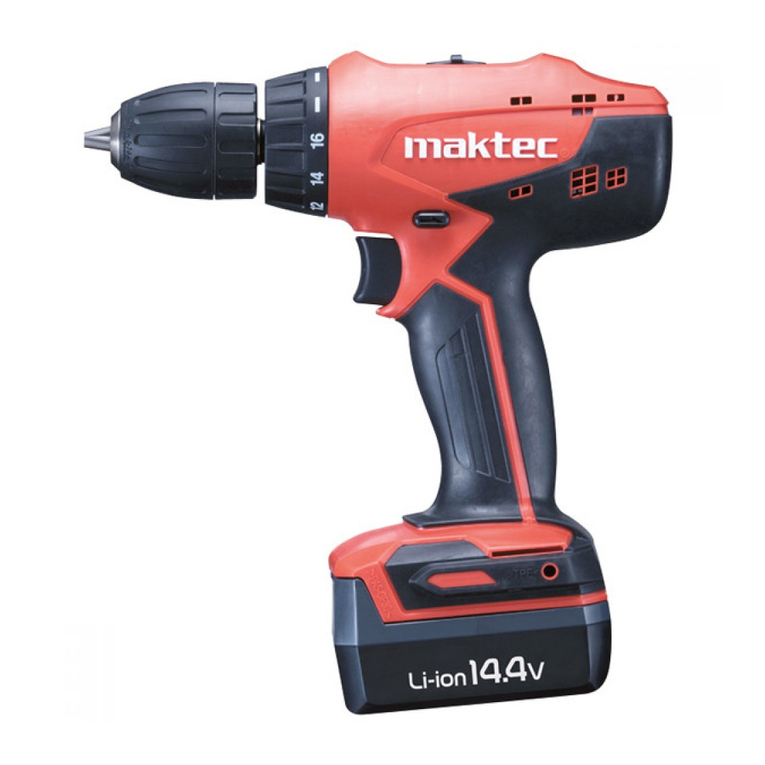
Maktec
Maktec MT070 User manual
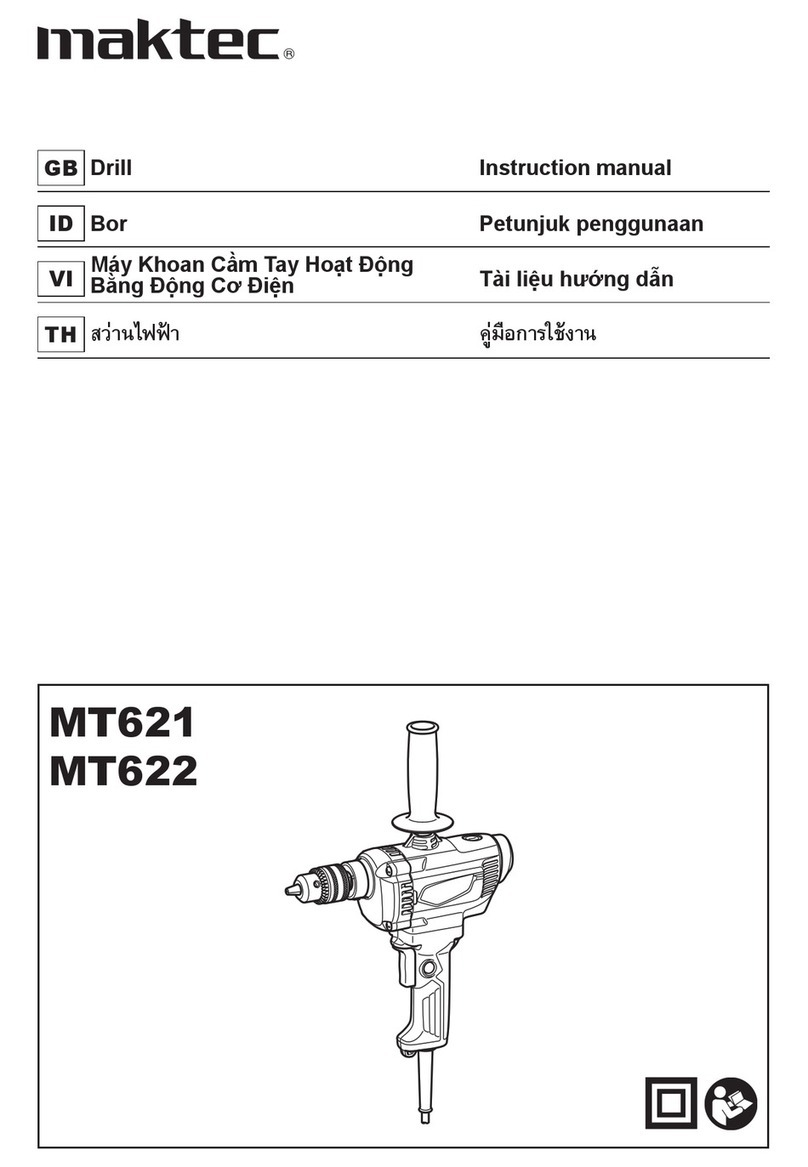
Maktec
Maktec MT622 User manual
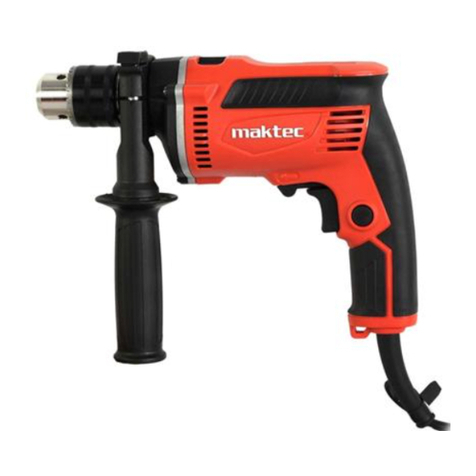
Maktec
Maktec MT816 User manual

Maktec
Maktec MT816 User manual
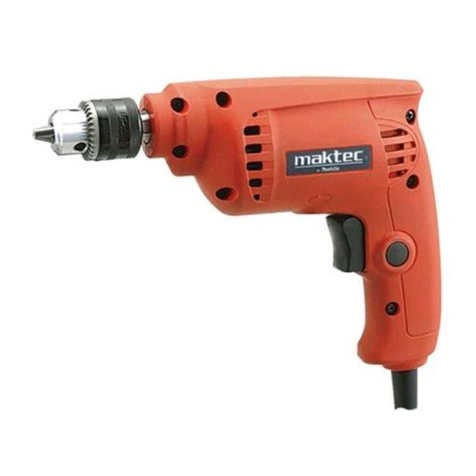
Maktec
Maktec MT602 User manual
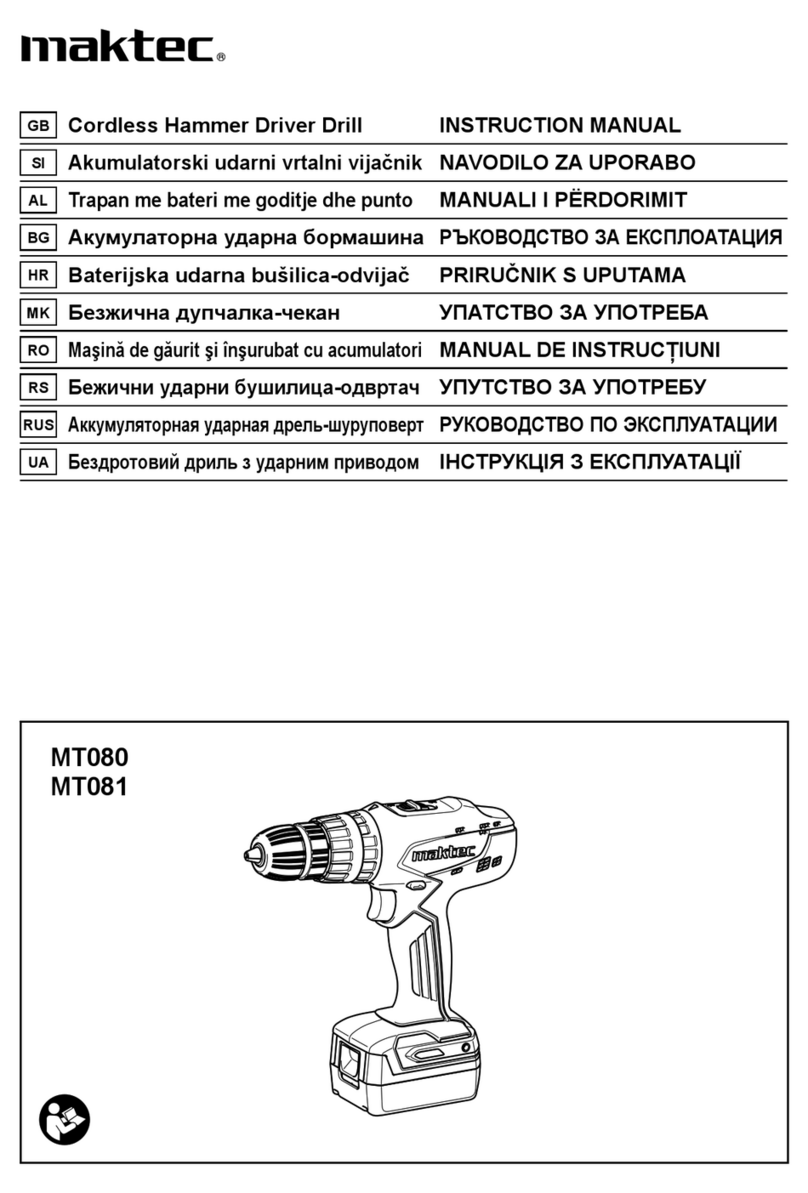
Maktec
Maktec MT080 User manual
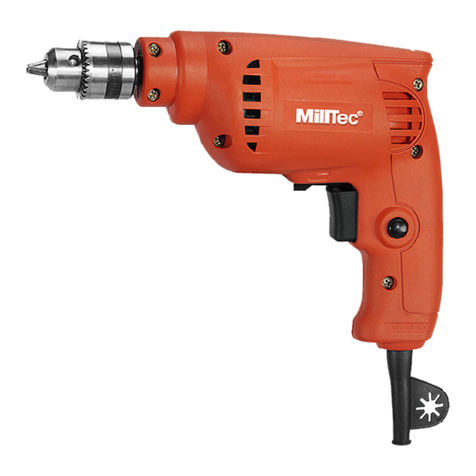
Maktec
Maktec MT603 User manual

Maktec
Maktec MT652 User manual
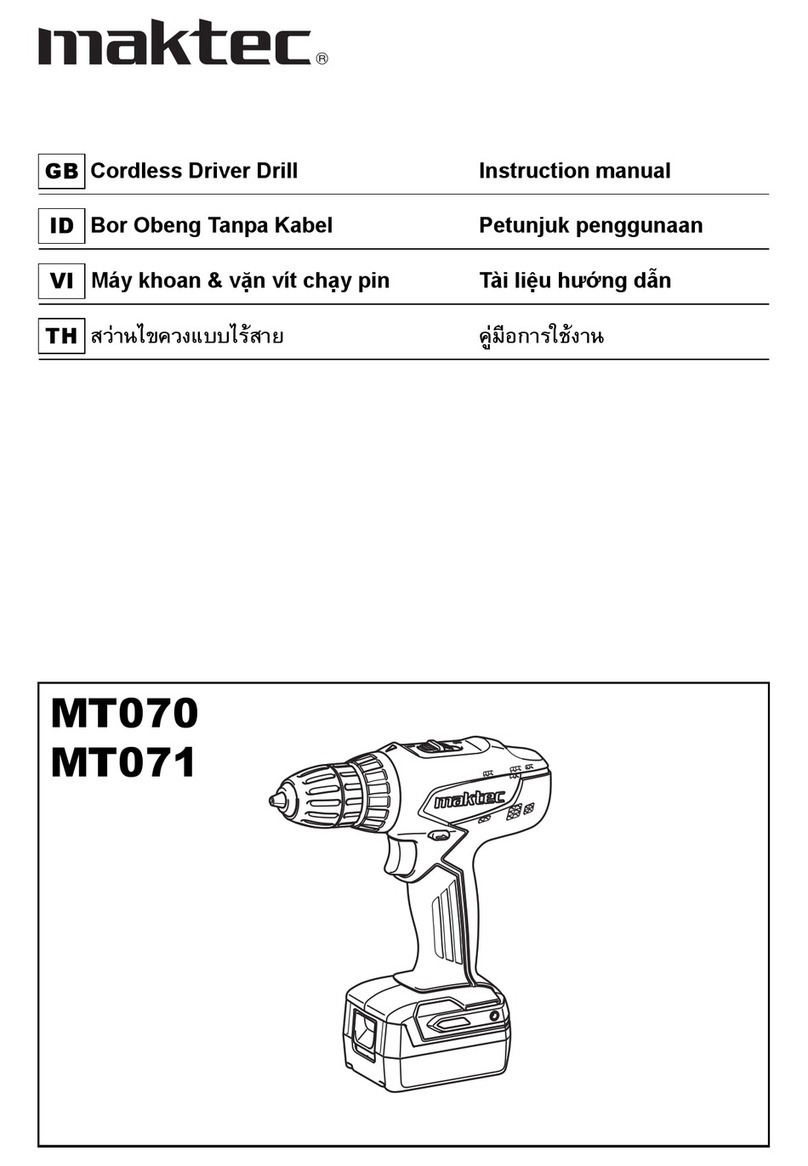
Maktec
Maktec MT071 User manual
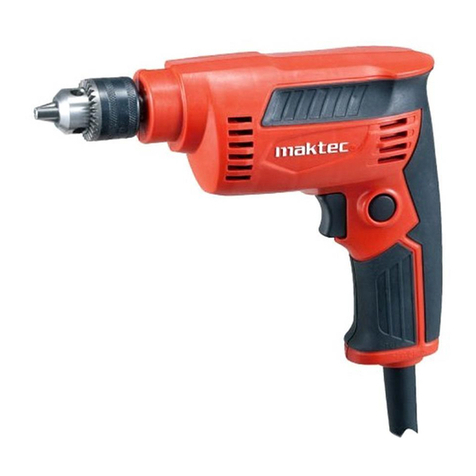
Maktec
Maktec MT652 User manual
Popular Drill manuals by other brands

Panasonic
Panasonic EY6780 Service manual
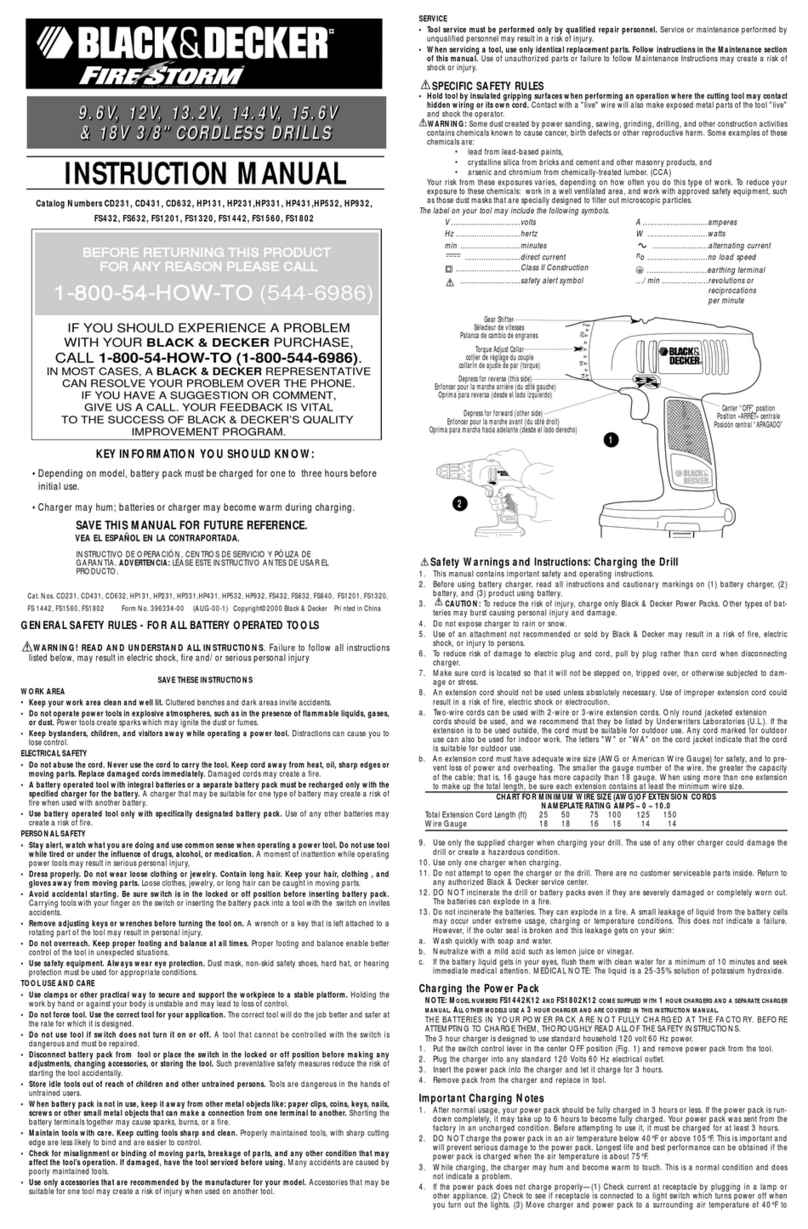
Black & Decker
Black & Decker Fire Storm CD632 instruction manual

Cooper Tools
Cooper Tools Quackenbush 120SC-112 Operation & service manual
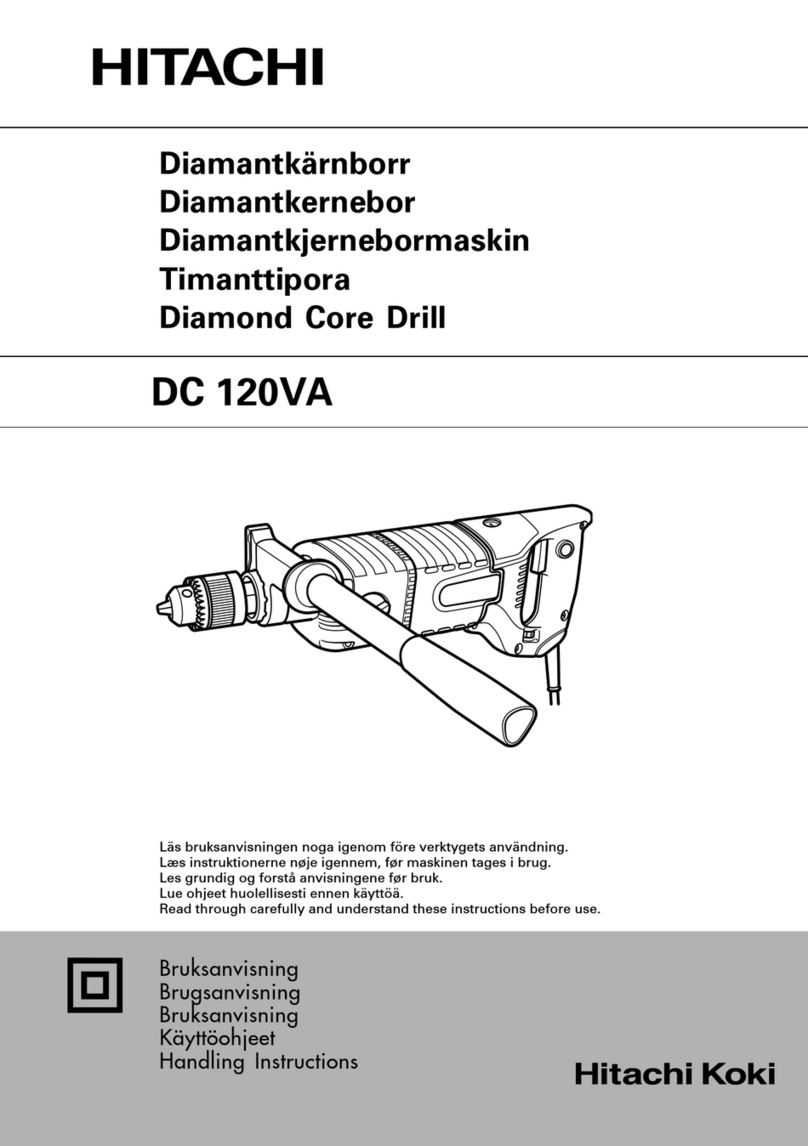
Hitachi
Hitachi DC 120VA Handling instructions
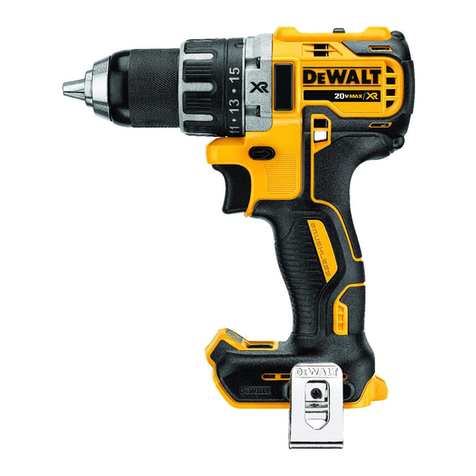
DeWalt
DeWalt DCD791B instruction manual
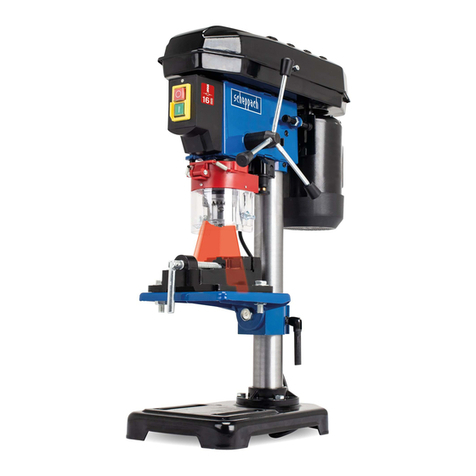
Scheppach
Scheppach DP16VLS instruction manual
